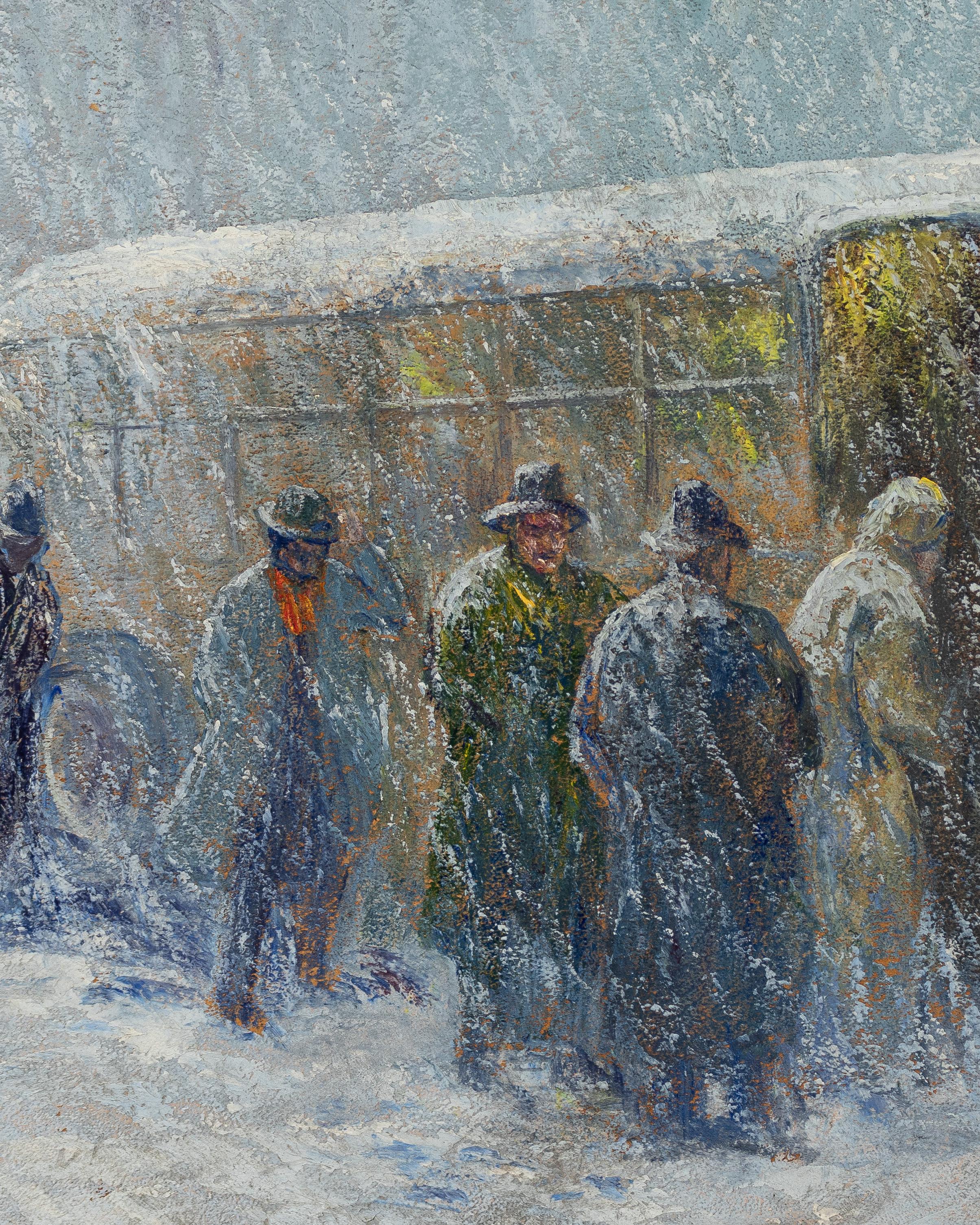BLACK ART AUCTION
UNSOLD LOTS





The prices noted include buyer’s premium but do not include shipping. Buyers are responsible for payment and arrangement of shipping for any purchase.
For more information on purchasing a lot, please email us at info@blackartauction.com or call (317) 986-6048.
Born in Madison, Georgia, the son of sharecroppers, Benny Andrews studied at Fort Valley State College (1948-50). After serving in the Korean War with the United States Air Force, he attended the School of the Art Institute in Chicago (1954-58), studying with Jack Levine and Boris Margo. He was generally viewed as an outsider, unyielding to the trends of abstraction at the time he was developing at the Art Institute. His work focused on figurative social commentary depicting the struggles, atrocities, and everyday occurrences in the world, especially in the African American community. In his drawings, paintings, and collages, Andrews continued to pursue representational art, which has been his focus throughout his long career. “Benny Andrews is a remarkable draftsman whose work is characterized by great economy of means,” Patricia P. Bladon wrote in Folk: The Art of Benny and George Andrews. “He infuses his drawings with the same integrity and passion which characterize his large-scale paintings.”
As his career flourished he continued to speak out on the inequalities facing African American artists and helped found the Black Emergency Cultural Coalition with fellow artist Cliff Joseph. He spent 29 years teaching art at Queens College and served as the Director of the Visual Arts program, a division of the National Endowment for the Arts (1982-84). His work received both
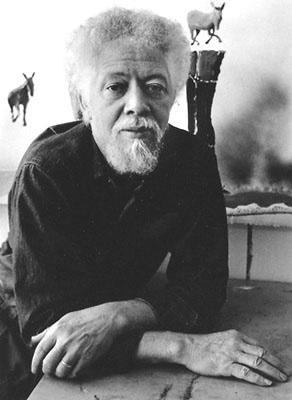
critical praise and commercial acceptance. Elected to the National Academy of Design in 1977, he was awarded premier fellowships and exhibited widely in this country and abroad.
Today, his work is found in the collection of many major museums, including the Brooklyn Museum of Art, NY; Detroit Institute of Art; Morris Museum of Art, GA; Hirshorn Museum, Washington D.C.; and the Metropolitan Museum of Art, NY.
Most recently, his work was featured in the exhibition Soul of a Nation: Art in the Age of Black Power. His work is currently on view in the exhibitions War Within War Without: MOMA’s Permanent Collection, NY; Seeing Differently: The Phillips Collects for a New Century, The Phillips Collection, Washington DC; and 50 x 50: Stories of Visionary Artists from the Collection, San Jose Museum of Art, CA.
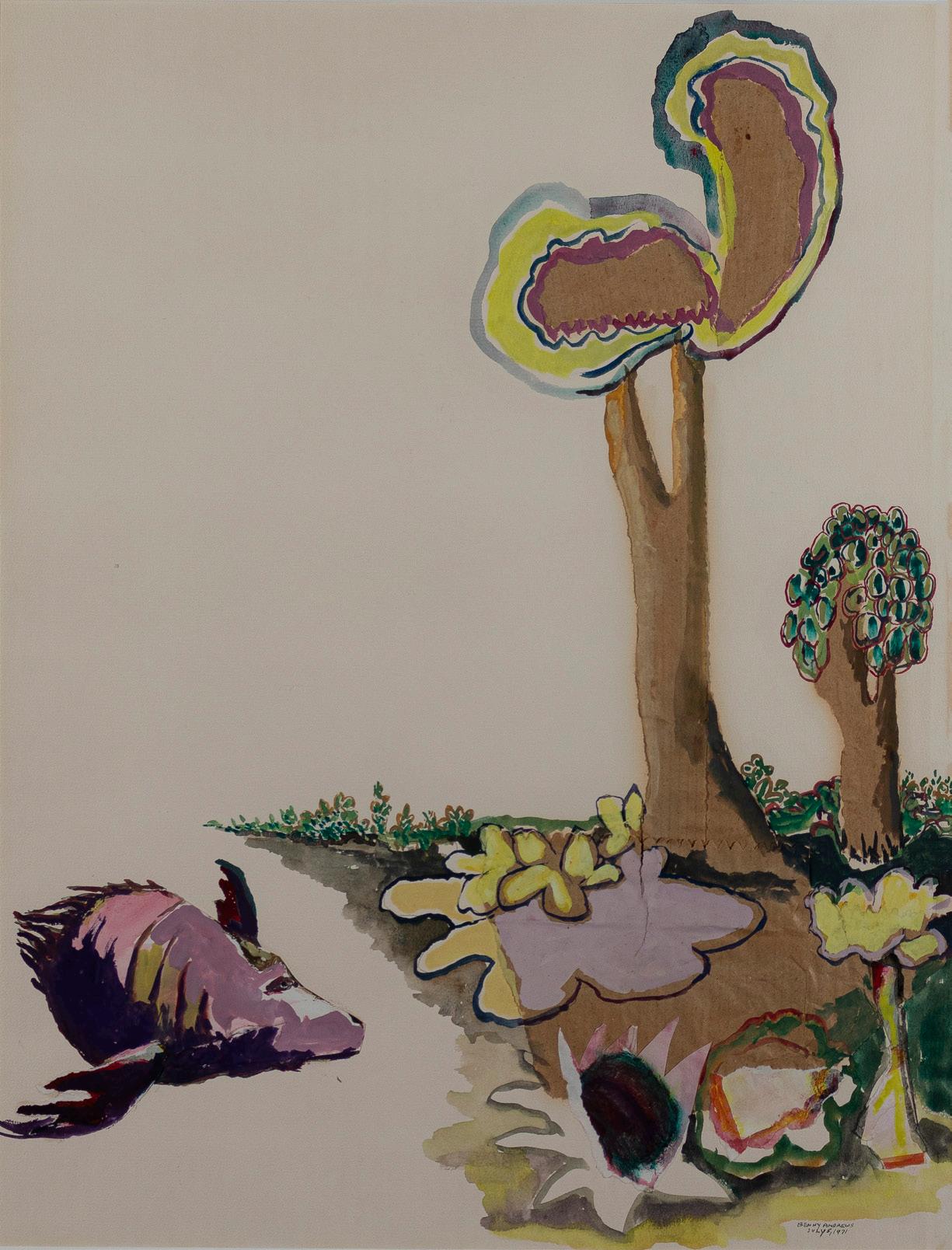
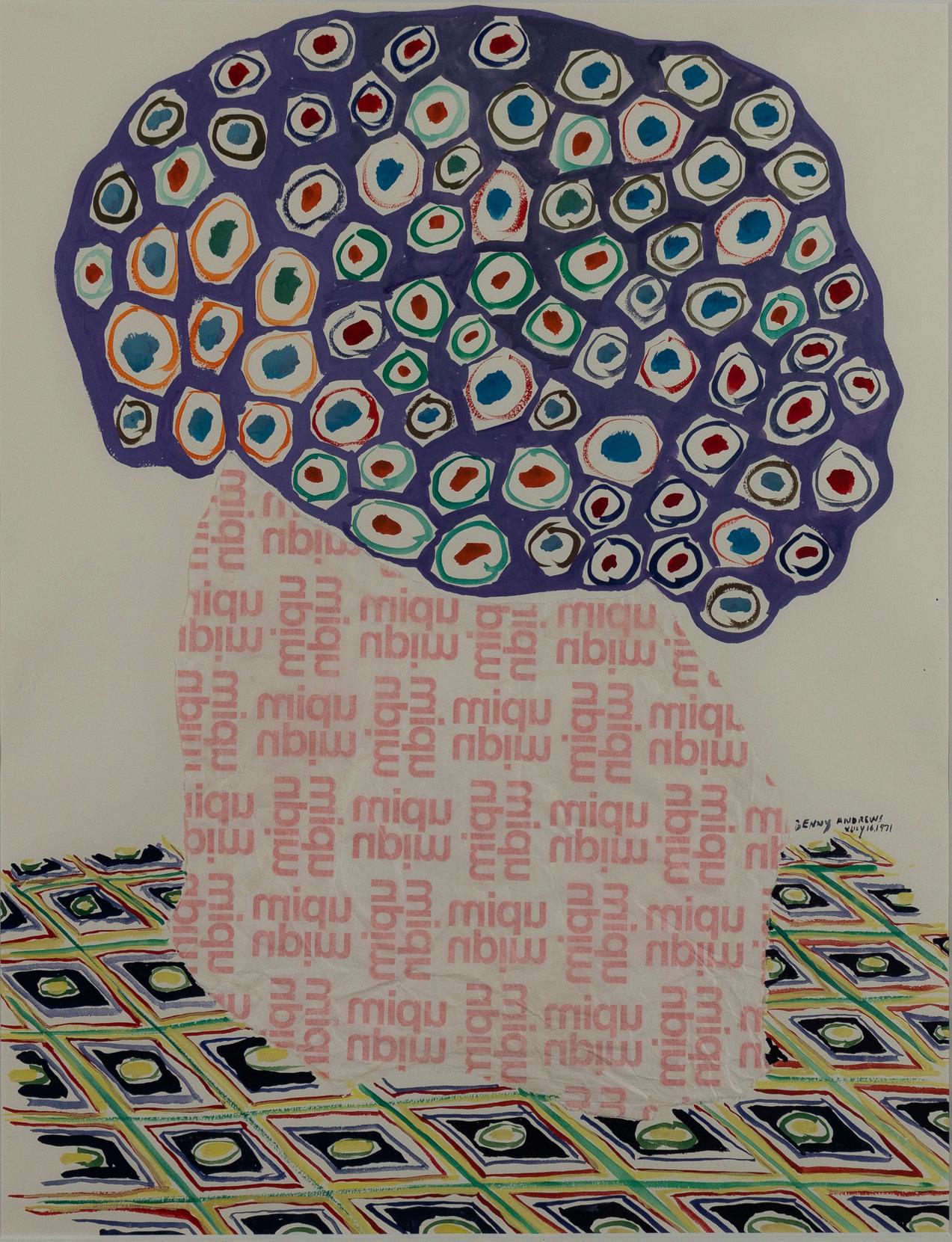

BENNY ANDREWS (1930-2006)
136 Willie, 1970 ink drawing on tan paper 17 x 11 inches (sheet) signed, dated, June 21, 1970, and titled; signed and titled verso
$700
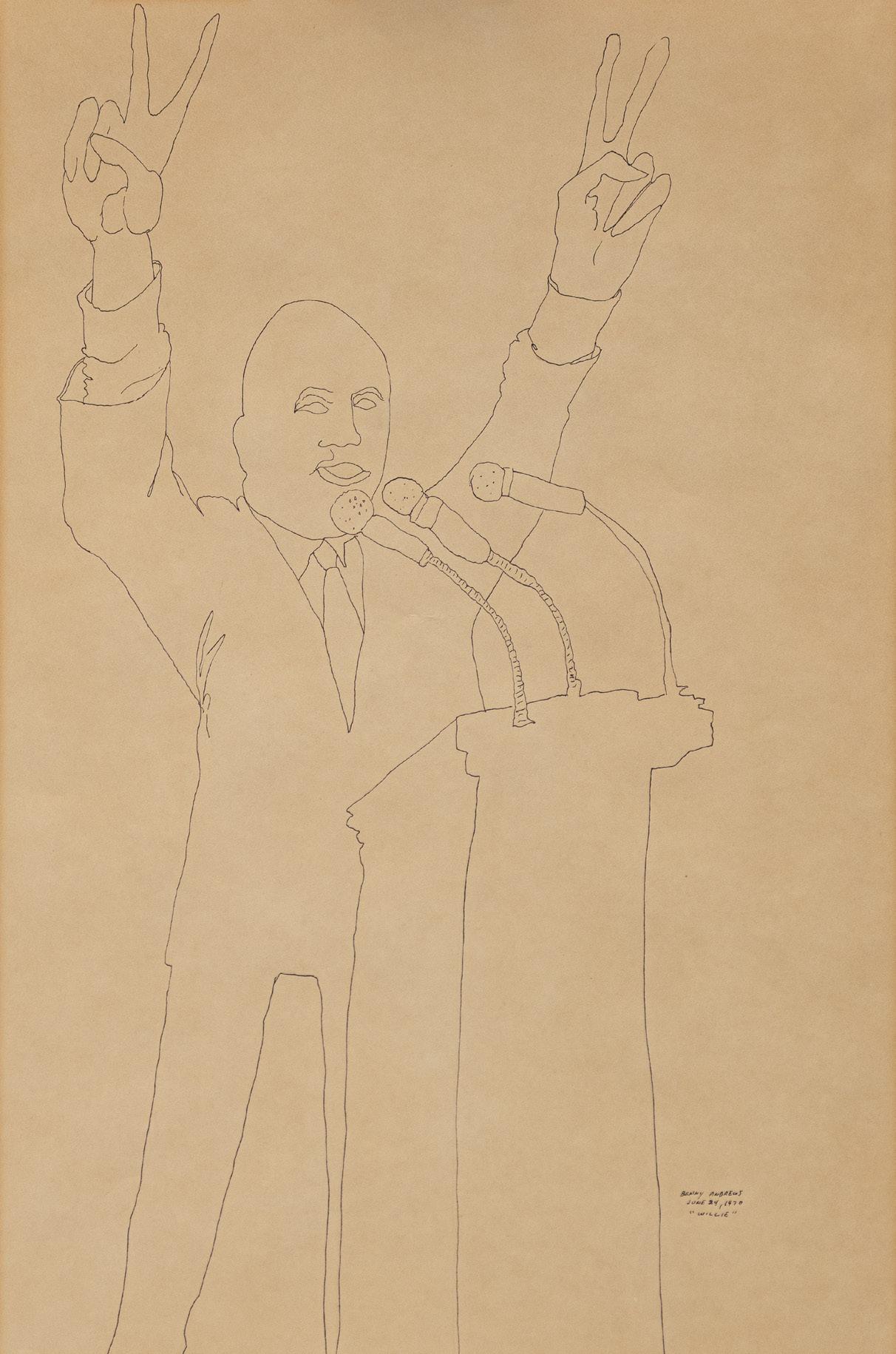
137 Mary Ellen, 1970 ink drawing on tan paper 17 x 11 inches (sheet) signed, dated, June 21, 1970, and titled; signed and titled verso
$700

Roland Ayers was a Philadelphia artist. He graduated from the Philadelphia College of Arts (now University of Arts) with a degree in fine art in 1954. His specialties were drawing and watercolor. Ayers was also a poet, and followed the teachings of selfawareness espoused by the Indian writer Jiddu Krishnamurti. He was generally considered a surrealist or magic realist.
Ayers exhibited in Blacks: USA: 1973, and in the controversial exhibition at the Whitney Museum in 1971, Contemporary Black Artists in America.

Romare Bearden was born in 1912 in Charlotte, North Carolina, but raised largely in New York City. His parents were active participants in the Harlem Renaissance, (his mother was the New York editor of the Chicago Defender), which provided the artistic and intellectual foundation for him to emerge as an artist of genuine talent, versatility, and conviction. Bearden studied at New York University, the Art Students League with George Grosz, and Columbia University. He was involved with the earliest incarnation of the Harlem Artists Guild and Charles Alston’s 306 group. After serving with the army, he was able to travel to Paris and study at the Sorbonne. When he returned from his travel, his work became more abstract. His early Social Realist works gradually gave way to cubism in the mid 1940’s while he began exploring religious and mythological themes.

In the early 1960’s, Bearden joined the artist collective Spiral. He began making collages as “an attempt to redefine the image of man in terms of the black experience.” Bearden’s early collages were composed primarily of magazine and newspaper cuttings. Together with his Projections, which were enlarged photostatic copies of these collages, they mark a turning point in his career and received critical praise.
Bearden achieved success in a wide array of media and techniques, including watercolor,
gouache, oil, drawing, monotype, and edition prints. He also made designs for record albums, costumes and stage sets, and book illustrations. Bearden opened Cinque Gallery with fellow artists Norman Lewis and Ernest Crichlow and was founding member of the Studio Museum in Harlem and the Black Academy of Arts and Letters. His work is included in major public collections including the Metropolitan Museum of Art, NY; Whitney Museum of American Art, NY; Philadelphia Museum of Art, PA; Museum of Fine Arts, Boston; and the Studio Museum in Harlem, NY.
Recent exhibitions of his work include: Romare Bearden: Artist as Activist and Visionary, David C. Driskell Center, University of Maryland College Park, MD, 2020; Abstract Romare Bearden, February 13, 2020 - March 28, 2020, DC Moore Gallery, NY; and Something Over Something Else: Romare Bearden’s Profile Series, February 28, 2020 –May 24, 2020, Cincinnati Art Museum. His work was also part of the exhibition Soul of a Nation: Art in the Age of Black Power 1963-1983, 2017-2021.

53 Salome, 1974 color screenprint
28-1/2 x 35-1/2 inches, full margins signed, dated and numbered. P.R. III, 46/100 GG#42 a large and striking image from the Prevalence of Ritual Portfolio, archival frame and mat.
Printed by Sirocco Screenprints, New York. Published by Cordier & Ekstrom, New York, and Ives-Sillman, Inc., New Haven, CT, with the blindstamp.
Illustrated: From Process to Print Graphic Works by Romare Bearden, essay by Mary Lee Corlett, Pomegranante, San Francisco, 2009, pp. 95-99
$5,500
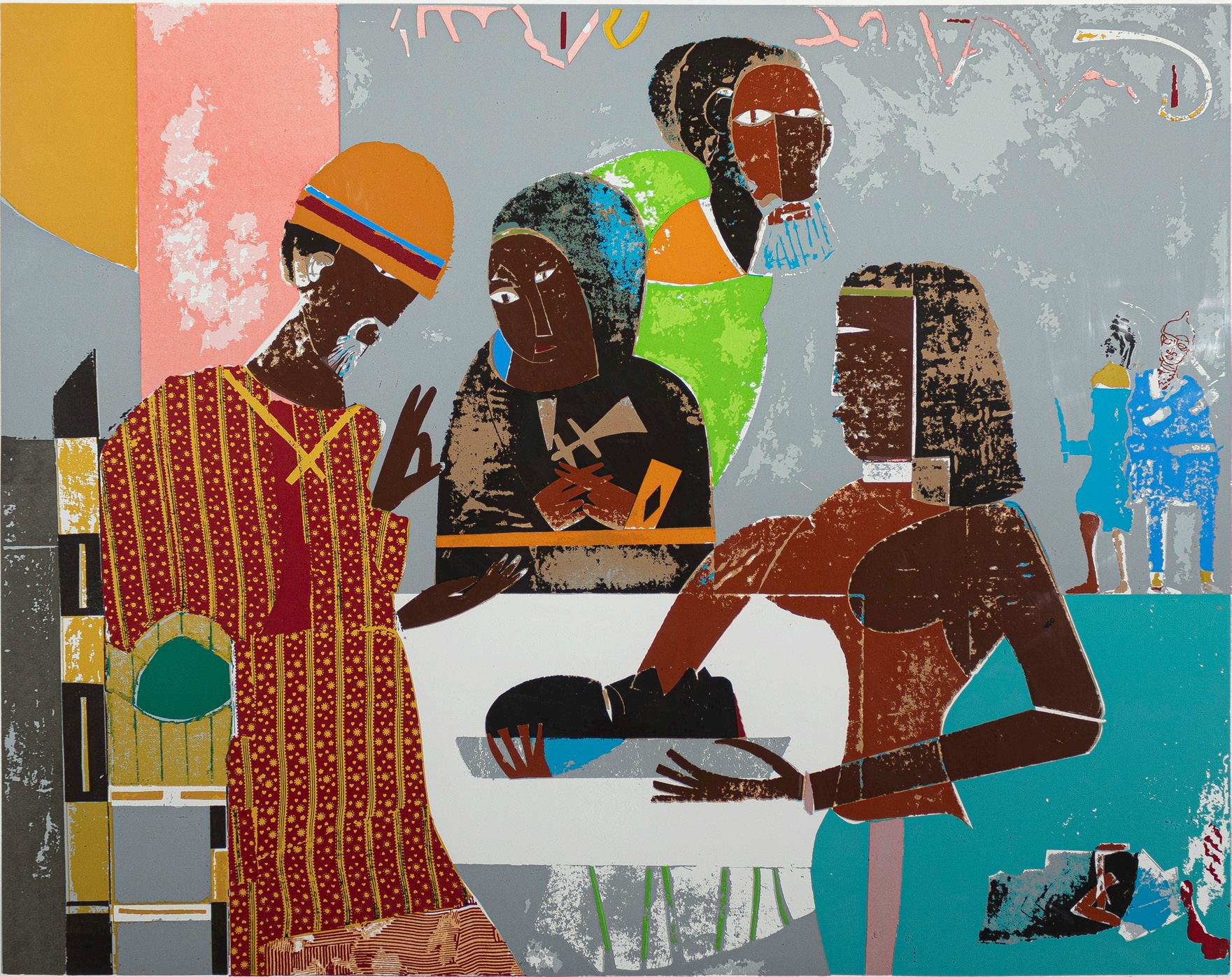
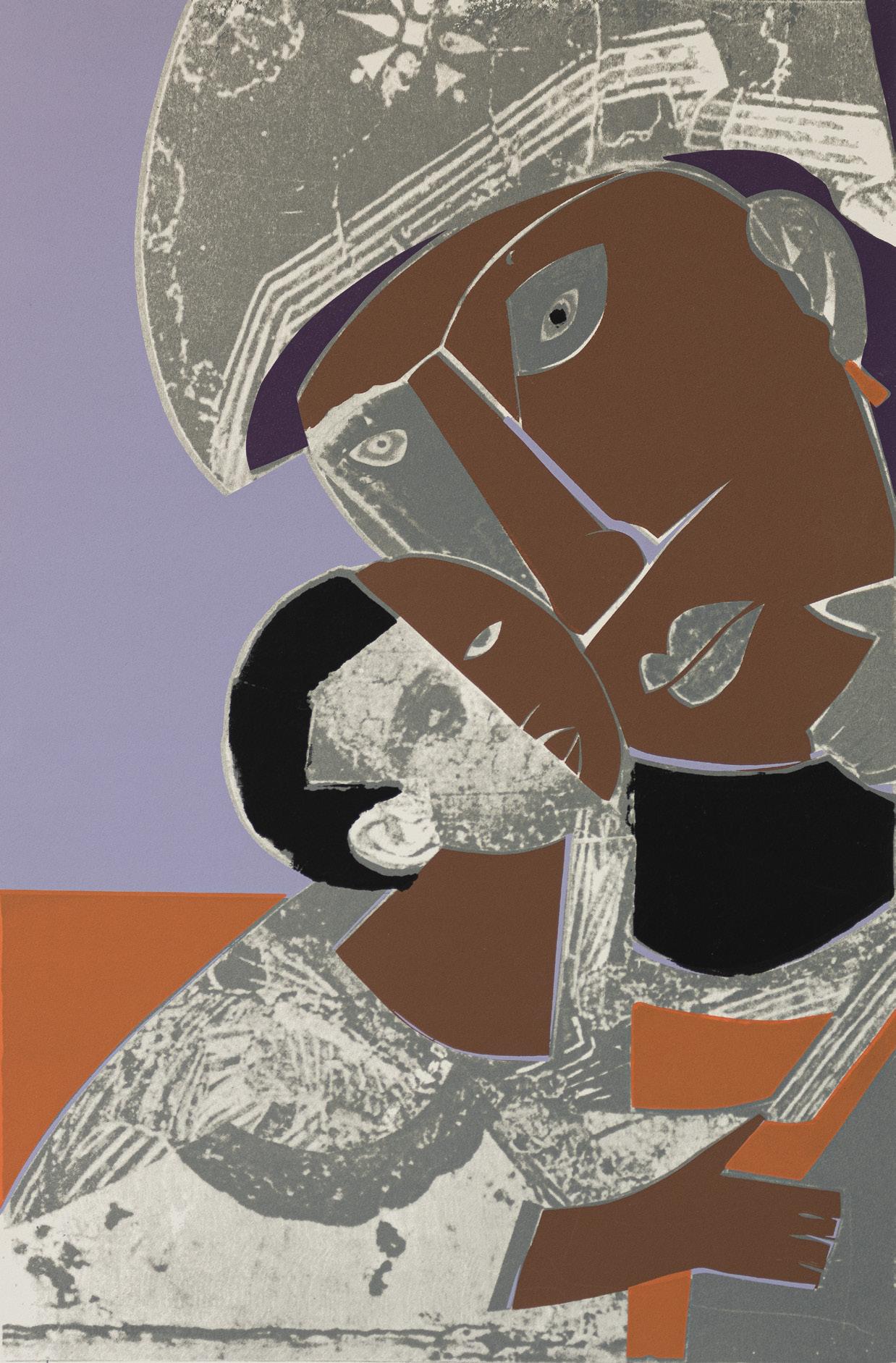
71 The Family, 1975 color aquatint and photo engraving 19-1/2 x 25 inches (sheet) signed and numbered 106/175
Printed by the Printmaking Workshop, New York and published by Transworld Art, New York, with the blind stamp lower right. From “An American Portrait, 1776-1976”. GG#55A. $6,000
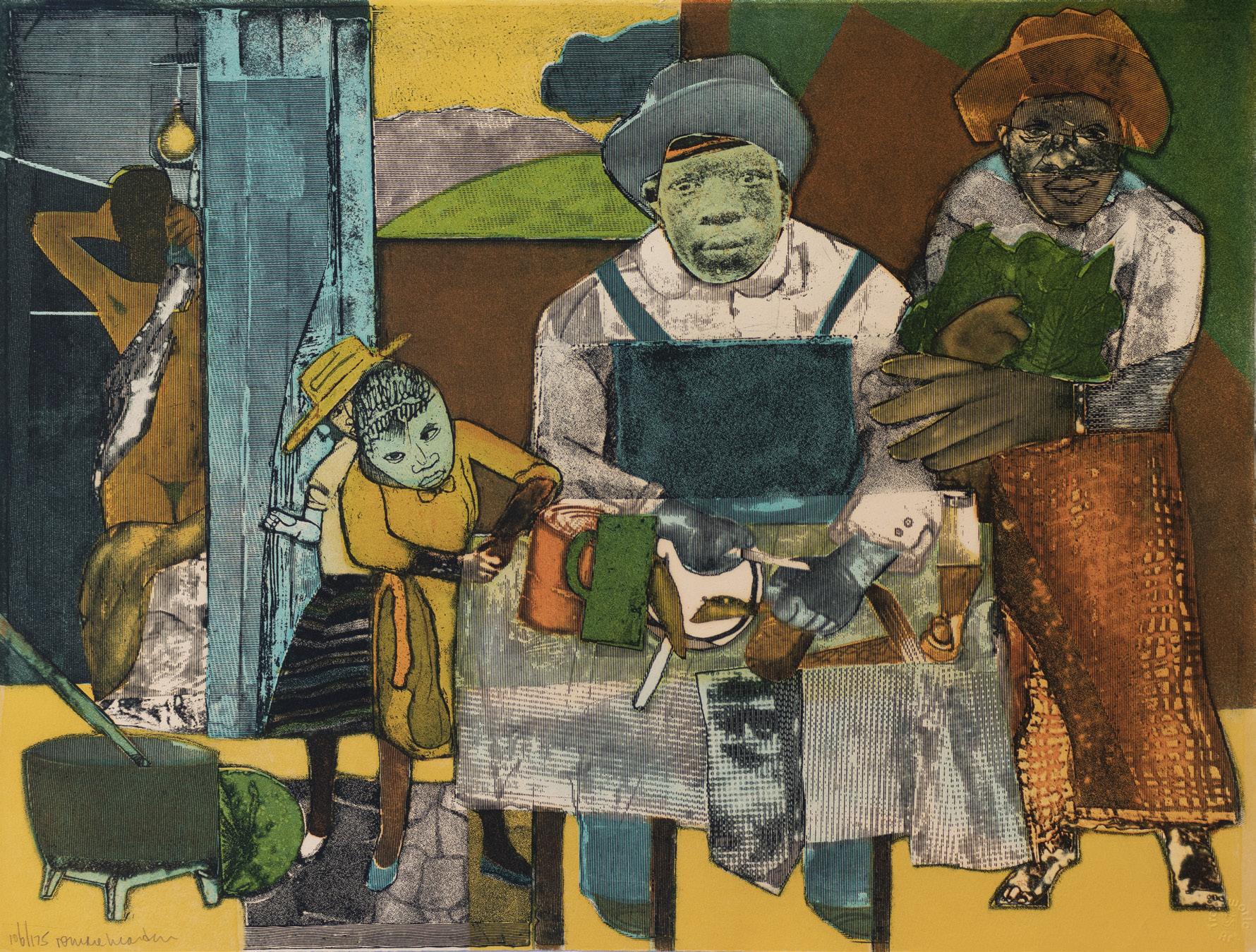
217 Landscape with People and Train (Watching the Good Trains), 1973-1975 sugar lift etching 11-1/4 x 16-1/4 inches (image), full margins signed and titled
This rare print bears an alternative title to the example pictured in Gelburg, written in Bearden’s hand in pencil. It is an unusual method using paint and a sugar solution on the engraving plate.
$4,250

Some of have labeled my particular style as social protest, but I beg to differ. If I would label my work at all, it would be called social reality.
Cleveland Bellow, Black Artists on Art v. 2, Lewis/Waddy, , p. 102-103
Cleveland Bellow worked primarily in the San Francisco Bay Area. He studied at the California College of Arts and Crafts in Oakland (BFA, MA). He also worked as an intern at the Fine Arts Museum of San Francisco. He worked as a painter, graphic designer, curator and consultant. He exhibited at the Oakland Museum, San Francisco Museum, Whitney Museum of American Art and many other venues around the Bay Area.
Bellow’s work was recently included in the exhibition, Soul of a Nation Art in the Age of Black Power which wrapped its run at the Museum of Fine Arts, Houston on August 30, 2020.
118 Nimba With Halo, 1975 lithograph 18 x 24 inches signed, titled, dated, and numbered 162/500 $600

Born in North Carolina in 1924, John Biggers’ body of work experienced a constant evolution throughout his career. He was an accomplished draftsmen as well as muralist - adept at weaving southern AfricanAmerican and African culture togetherincorporating sacred geometry and complex symbolic elements.
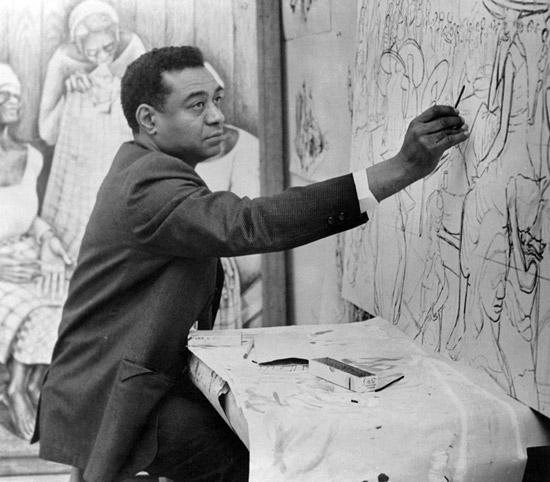
Biggers attended Hampton Institute (University) in the early 1940s, and befriended Charles White and Elizabeth Catlett. Much of his early work was social realist - depicting the everyday hard work and perseverance of the African American community.
In 1949, Biggers moved to Houston, TX and chaired the art department at Texas State University (later Texas Southern). The artist yearned to penetrate the invisible but very real curtain which seemed to separate American blacks from Africans. For 15 years, he tried and failed to get fellowships to Africa. Finally he made it in 1957, on a UNESCO grant which provided seven months of living and traveling through Ghana and western Nigeria.
“I had a magnificent sense of coming home, of belonging,” he says - and he doesn’t mean it sentimentally.
“I recognized at once the Africanisms in our life in America, which we simply had not been able to recognize and to claim,” Biggers asserts. The sight of African men and women building their own houses, hewing and shaping their own ax handles, weaving their own quilts, making their own chairs, impressed him deeply. “And it reminded me of my own childhood times in North Carolina.”
-Ann Holmes, It is Almost Genetic, The ARTGallery Magazine, April 1970, p. 38.
Biggers’ work may be found in the collections of the Brooklyn Museum, NY; Atlanta University, GA; Barnett-Aden Collection, Washington D.C.; Dallas Museum of Art, TX; Howard University, Washington D.C.; and the Smithsonian American Art Museum.
90 Holy Family, 1983 conte crayon on paper 27 x 22-1/2 inches signed; signed, titled and dated verso, with small artist’s tag
Provenance: the artist to a significant private collection, Chicago, IL $25,000

Grafton Tyler Brown was a painter, graphic designer, and lithographer who worked in California in the late 19th century. Brown worked in Peter S. Duval’s print shop in Philadelphia in the 1850s. By 1865, he had founded his own lithography business in San Francisco, designing stock certificates for a wide variety of companies ranging from ice to mining corporations, as well as admission tickets, maps, sheet music and advertisements.
In the 1870s, Brown moved to Victoria, British Columbia to work on a geo graphical survey for the Canadian government. He held his first exhibition of paintings in 1883 in Victoria, which included 22 local landscapes. Brown lived in Portland from 1886-1889 and Wyoming in 1891, before returning to California, all the while painting the local scenery.

In 1892, he left the West and moved to St. Paul, Minnesota, where he worked as a draftsman and civil engineer. Brown lived out his remaining 25 years in St. Paul, Minnesota.
Right: The artist at work in his studio; Collection of British Columbia Archives and Records Service.
55 The Golden Gate, Yellowstone National Park, 1888 oil on canvas board 16 x 10 inches signed and dated; titled verso, and not ed, “No. 5”, also verso.
$15,000

54 Old Faithful Geyser, Yellowstone National Park, 1888 oil on canvas board 16 x 10 inches signed and dated; titled verso, along with “spouts every 65 minutes to a height of from 130 to 160 feet. Size of opening 2 ft by 6 ft; plays from 2 to 5 minutes. Noted: “No.6” also on verso.
$15,000

William Sylvester Carter was born in St. Louis, MO and moved to Chicago in 1930 to study art at the School of the Art Institute of Chicago and the University of Illinois. In order to earn room and board, Carter worked as a janitor at the Palette and Chisel Club (an allwhite club, to which he became an honorary member in 1986).

He was among the artists represented in the American Negro Exposition assembled by Alonzo Aden, with the Harmon Foundation and the WPA in Chicago, 1940. Carter was awarded first prize for a work in watercolor. The same year, he exhibited at Howard University Gallery of Art. Carter also worked for the WPA in Illinois in 1943, and taught art at the historic South Side Community Art Center.
Carter worked in many styles and addressed virtually any subject matter from the traditional portrait to completely nonobjective compositions. Although Carter humorously and vehemently vowed until the day he died (at 87) he was too young to have a painting style, this colorful, cubistinfluenced work is a fine example of a style in which he worked regularly.
Carter’s work, The Card Game, 1950, was included in the exhibition, They Seek A City, Chicago and the Art of Migration (p.87) which was held at the Art Institute of Chicago in 2013.
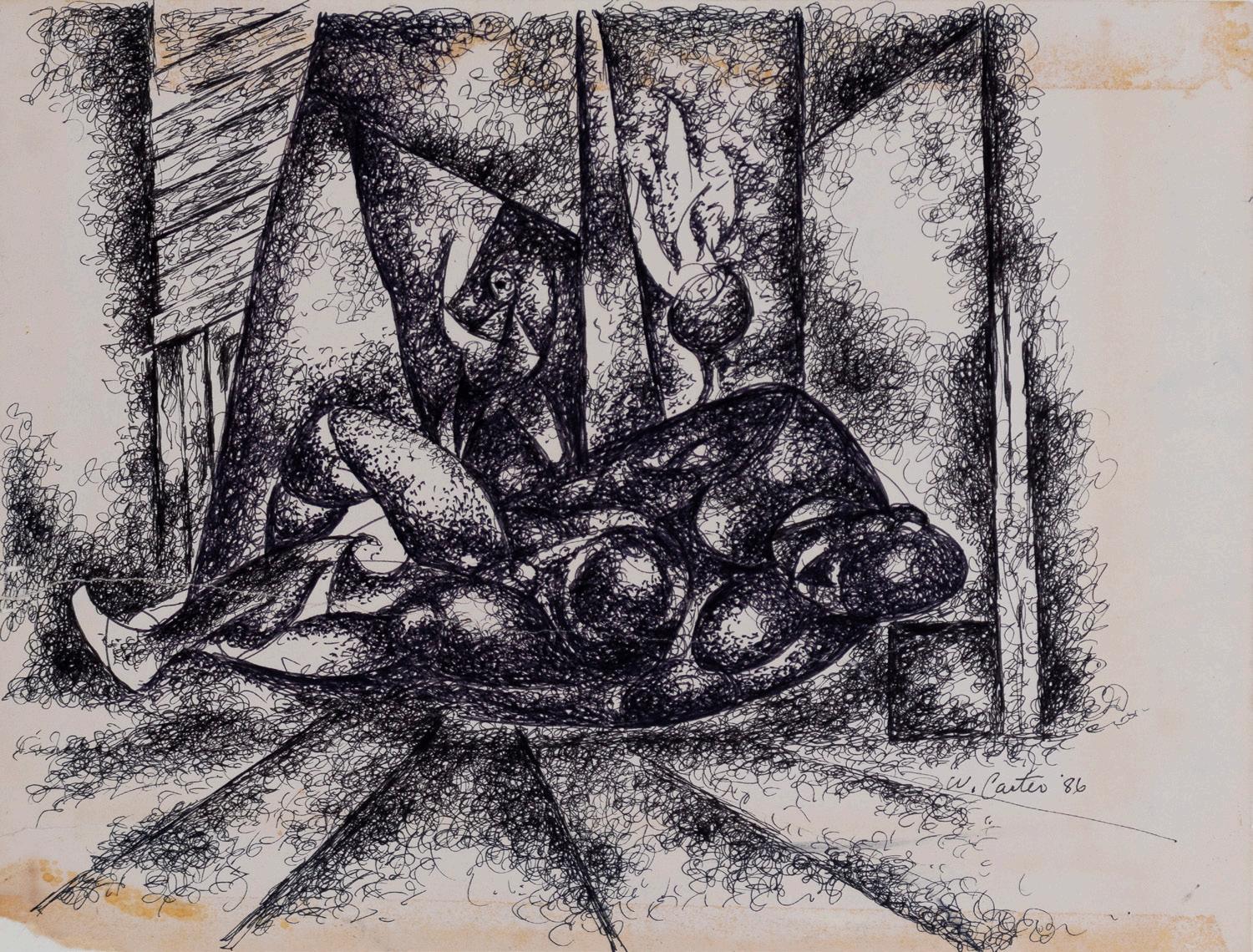
In addition to being an accomplished painter, Bernard Casey was an acclaimed poet, television and movie actor and player in the NFL. Casey was born in a small mining town in West Virginia in 1939. He was educated at Bowling Green State University, OH where he earned both a BA and MFA.
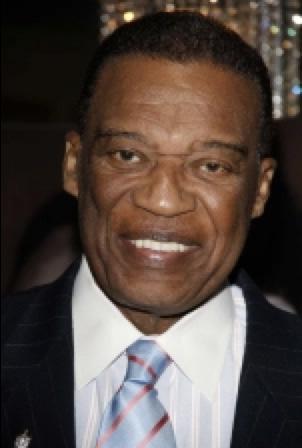
Samella Lewis described him as a “colorist with a strong sense of design, (who) frequently uses geometric shapes in combination with subtle color changes. His works are quiet, but penetrating, and some are adorned with words of social significance. The locales they depict could be almost any place in the world, but their poetic statements generally deal with the social plight of African Americans in the United States. Since Casey is also a poet, this combination of forms and words is not unnatural.”
African American Art and Artists, 180 Casey’s work has been shown in the seminal exhibition, Los Angeles 1972: A Panorama of Black Artists, Los Angeles County Museum of Art, 1972; Black Artists on Art: The Legacy Exhibit, Oakland, CA, 2015; American Black Art: Black Belt to
Hill Country: the Known and the New, Battle Creek Art Center, MI, 1977, and the California African American Museum.
Casey also served on the Board of Trustees at the Savannah College of Art and Design.

Social realist painter, illustrator, and educator, Ernest Crichlow was born in 1914 in Brooklyn, NY. He began studying commercial art at the School of Commercial Illustrating and Advertising Art, NY, and fine art with the Art Student’s League.

In 1930, Crichlow found a mentor in Augusta Savage when he joined the Harlem Artist’s Guild, alongside other such notables as Romare Bearden, Jacob Lawrence, and Norman Lewis. Here he found his niche creating social realist works that packed a powerful message. During the Depression, he found work with the WPA, teaching art and working on mural projects. He used this platform to create works that captured “the indomitable inner strength, intrinsic beauty, dignity, and essential humanity of the African American community.”
He continued to support his community by establishing Brooklyn’s Fulton Art Fair in 1958. In 1969, along with Romare Bearden and Norman Lewis he co-founded the Cinque Art Gallery, dedicated to supporting and exhibiting the works of emerging black artists. He created a 25 panel mural in 1976 for the Boys and Girls High School of Brooklyn depicting people at work in various trades and careers as an inspiration for those students to achieve excellence. Crichlow was also known for his illustrations and children’s books.
Throughout his career, he participated in notable exhibitions at the American Negro Exposition, Chicago, 1940; the New York World’s Fair; the Harlem Community Center; the Downtown Gallery; ACA Gallery; and Atlanta University. He was honored as one of ten black artists from the National Conference of Artists by President Jimmy Carter in the late 1970’s.
Crichlow’s, Reflections of Another Time, was included in Southern Journeys, African American Artists of the South, a traveling museum exhibition, originating out of the Appleton Museum of Art, Ocala, FL in 2011. In 2018, his work was included in Truth and Beauty: Charles White and His Circle held at Michael Rosenfeld Gallery, NY.
19 Reflections of Another Time, 2001 offset color lithograph
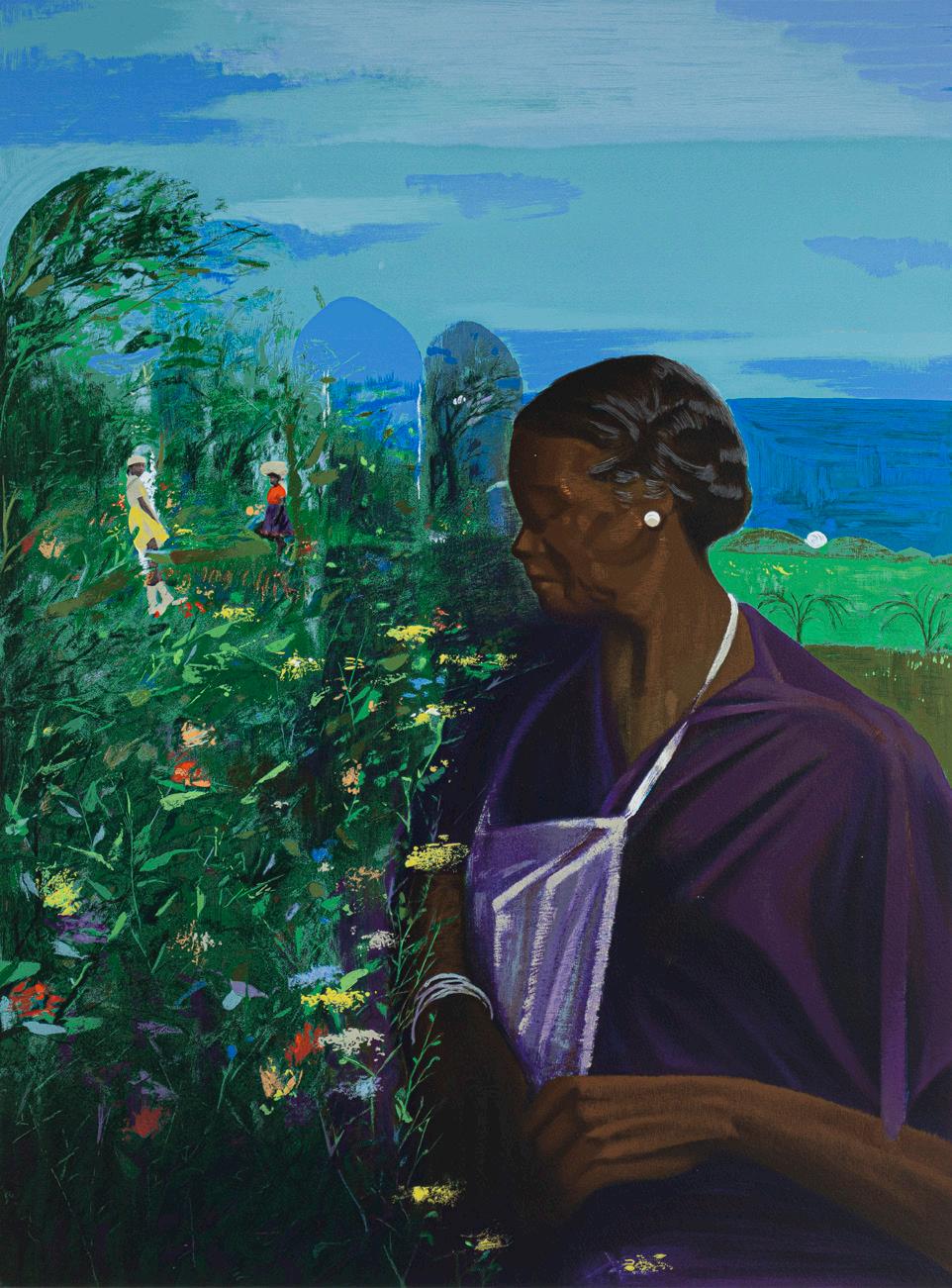
29 x 21-3/4 inches, full margins signed, titled, dated and numbered 49/125
$3,125
20 Mother and Child, 1988 lithograph

24 x 17-1/2 inches (full margins) signed, titled, dated, numbered 23/40
$2,500
After studying and teaching in the Midwest, Aaron Douglas moved to New York City where he became a part of Alain Locke’s New Negro Movement. There, he studied with German/ American portrait artist, Winold Reiss, who encouraged Douglas to introduce African imagery and themes into his paintings. As Douglas developed this individual style, he became the figure to which the Harlem Renaissance aspired to emulate.
Aaron Douglas received two Rosenwald Fellowships, one for study in France and the other to tour Haiti and the American South. He was also elected president of the Harlem Artists Guild in 1935 and worked to obtain WPA recognition and support for African-American artists.
In 1937, he founded and chaired the Art Department at Fisk University in Nashville, Tennessee, where he remained involved until 1966. Douglas died in Nashville in 1979. His work may be found in the collections of Fisk University, Nashville, TN; Corcoran Gallery of Art, Washington D.C.; and the de Young Museum, San Francisco.
Photo: Aaron Douglas, African American Modernist, Susan Earle, Yale University Press, p. 92.
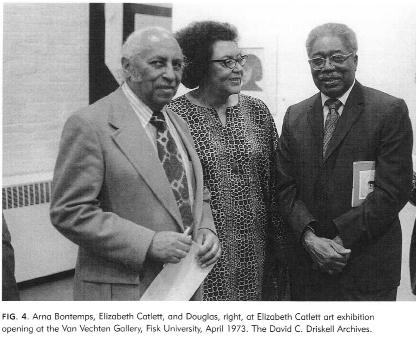
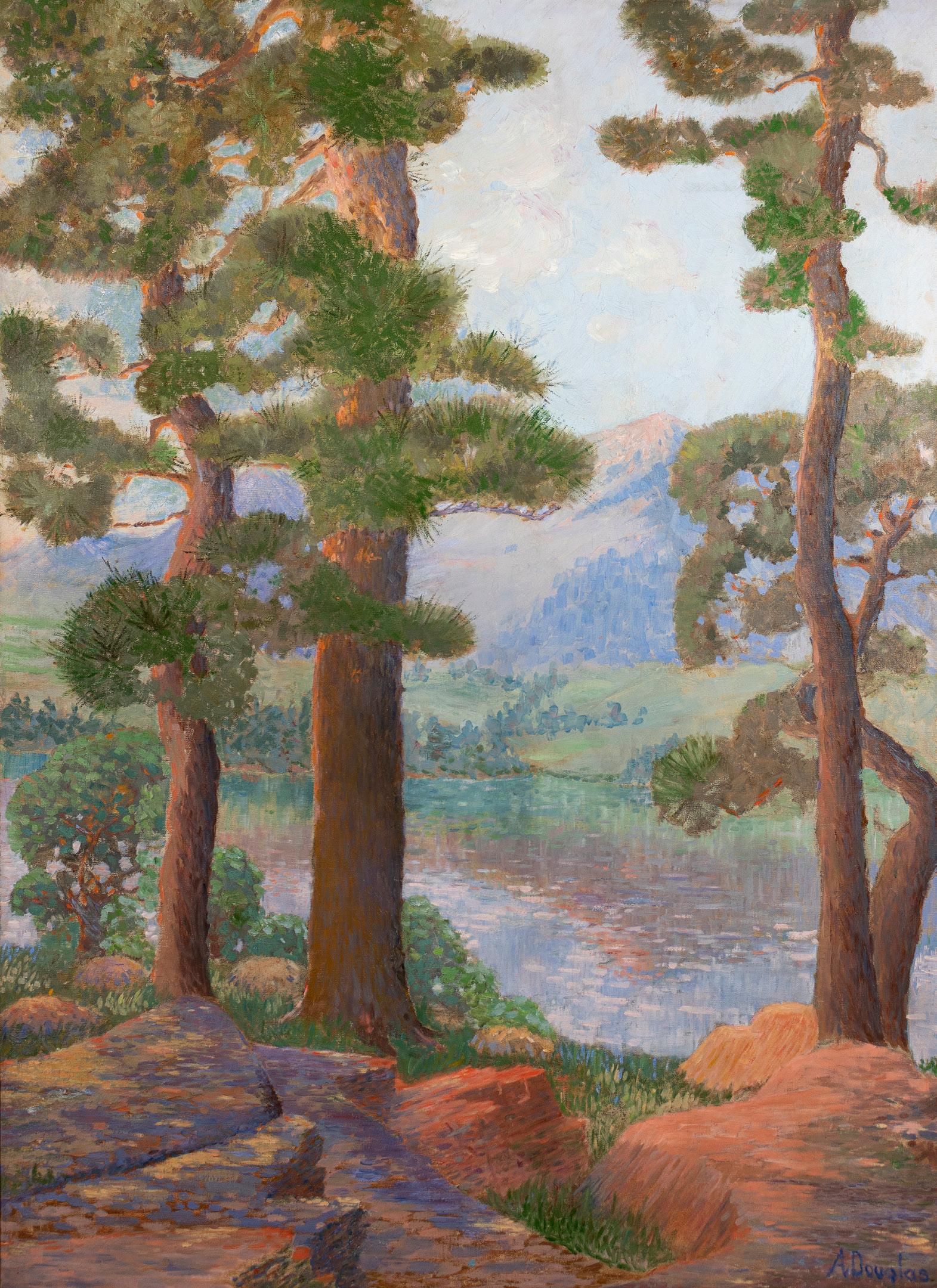
57 Paris Street Scene, c. 1936 oil on canvas 25-1/2 x 32 inches signed $16,000
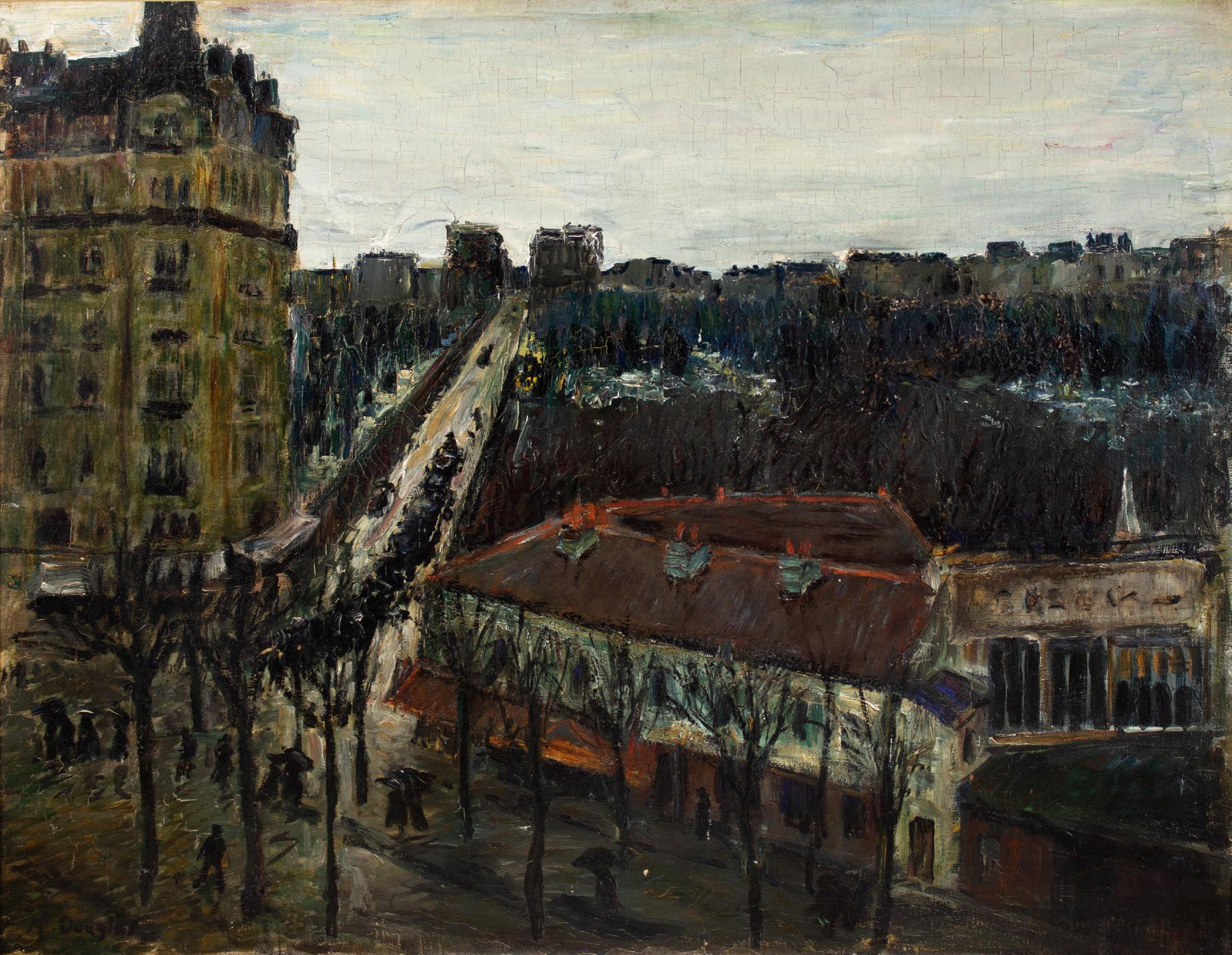
Artist, curator, scholar and distinguished professor emeritus David Driskell was born in Eatonton, GA in 1931. He completed the art program at the Skowhegan School of Painting and Sculpture, Maine, in 1953. He went on to attend Howard University and received his MFA from the Catholic University of America, Washington D.C. Prof. Driskell explored post-graduate study in art history at the Netherlands Institute for the History of Art in The Hague.
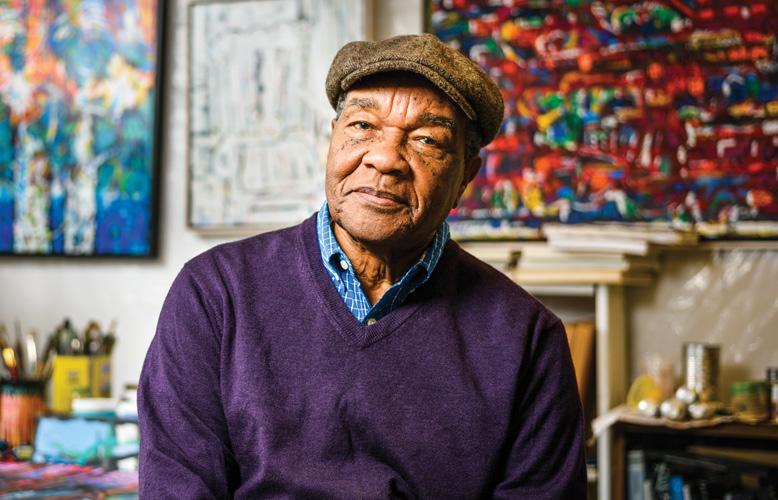
He began his career as an educator at Talledega College in 1955. In 1977, he joined the faculty at the University of Maryland, College Park, where he remained for the rest of his career. Upon his retirement, the David C. Driskell Center was established to honor his legacy and dedication to preserving the rich heritage of African American visual art and culture. In 1976, Prof. Driskell curated the important exhibition, Two Centuries of Black American Art: 1750- 1950, which was held at the Los Angeles County Museum of Art. He has authored multiple exhibition catalogs throughout his career.
As an artist, he works in collage and mixed media -oil paint, acrylic, egg tempera, gouache, ink, marker, and collage on paper and on canvas (stretched and unstretched). Prof. Driskell has worked with the Experimental Printmaking Institute of Lafayette college and Raven Editions. The exhibition, Evolution: Five Decades of Printmaking by David C. Driskell, held in 2009 at the High Museum of Art, GA was the first exhibition to highlight his printwork.
Prof. Driskell’s work has recently been
included in David Driskell: Artist & Scholar of the African American Experience, Oct. 2019 - Jan. 2020, Morris Museum of Art, GA; David Driskell: Resonance, Paintings 1965-2002, 2019, DC Moore Gallery, NY.
His work has also been featured in the following group exhibitions: Riffs and Relations: African American Artists and the European Modernist Tradition, Feb. 29 - May 24, 2020, Phillips Collection, Washington D.C.; Tell Me Your Story, Feb. 8 - May 17, 2020, Kunsthal Kade, Amsterdam; The Seasons, Nov. 16, 2019 - March 1, 2020, Nassau County Museum of Art, NY; and Soul of a Nation: Art in the Age of Black Power, Museum of Fine Arts, Houston.
The University of Maryland’s David C. Driskell Center for the Study of Visual Arts and Culture of African Americans and African Diaspora is dedicating this academic year to commemorating its namesake’s life and work—combining teaching, art history scholarship and writing, and curation and the practice of art.
Photo: David Hills, Down East Magazine, March 2017
112 The Farmer and His Wife, 2009 colored lithograph and serigraph on heavy wove paper 23 x 18 inches (image) 30 x 22-1/2 inches (sheet) signed, titled, dated and numbered 34/100, blind stamp Raven Editions $2,800

110 Path Through the Landscape, 1953 oil on canvas 20-1/’2 x 16-1/4 inches signed and dated
Provenance: Earl Hooks, Jr (the estate of Earl Hooks). Hooks and Driskell were great friends and taught and made art together. This landscape, gifted to his friend, is an intimate work that is one of the earliest paintings to come to market (Driskell was only 22 years old at the time of its execution).
$6,000
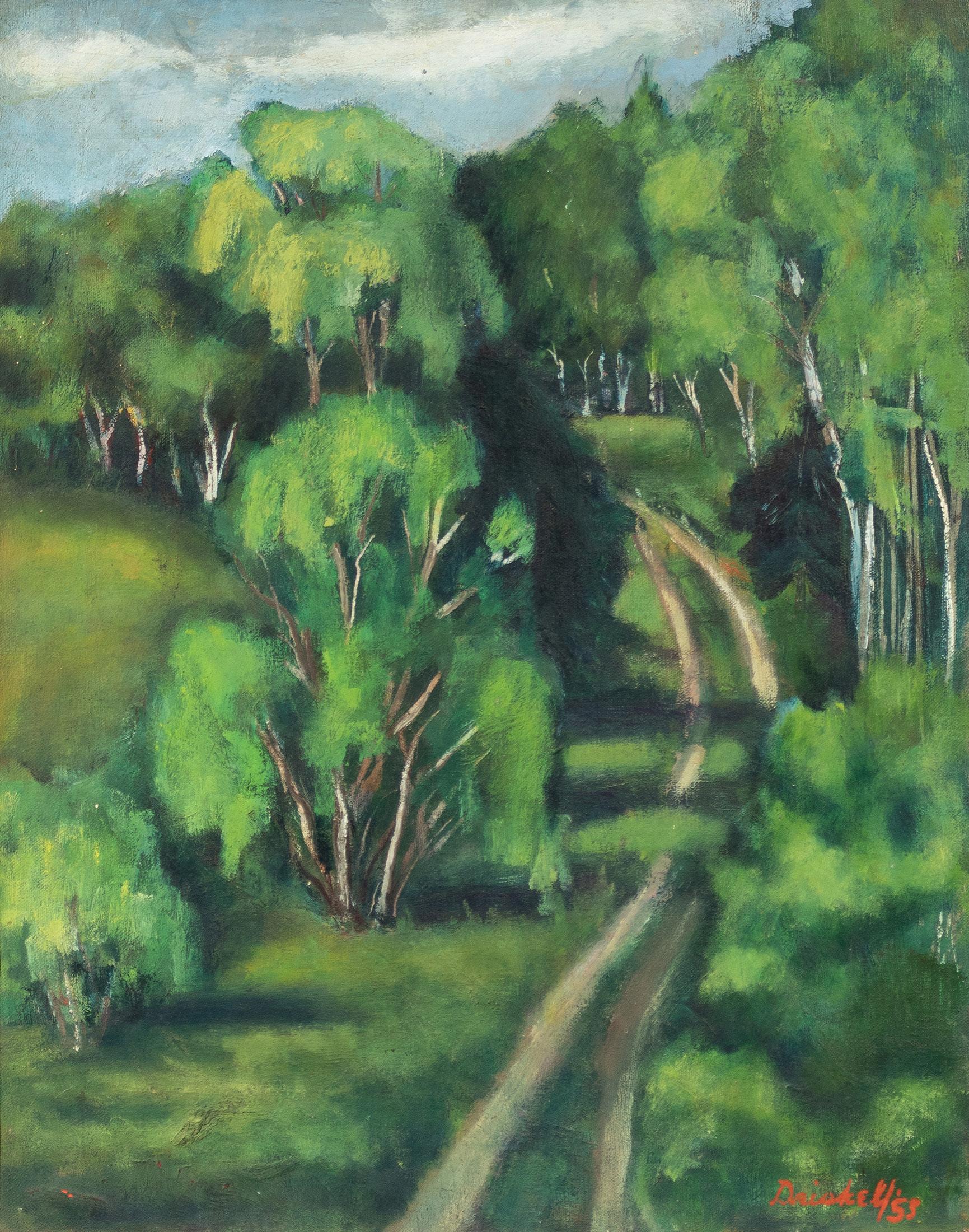
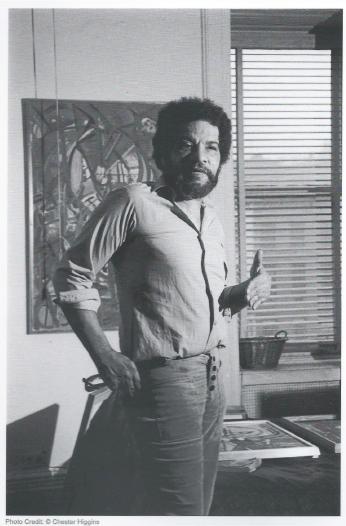
Let experience be a part of you as a human being…Even though we’re black and we’ve been hurt by many people, we still have to give of ourselves. We sort of have to be universal. Nor do we lose blackness by being universal.
Gentry was born in Pittsburgh, but was raised in Harlem before WWII, where he had some exposure to art under the programs of the WPA. He served in the war, first in North Africa and then in Germany. He returned to Europe in the latter 1940s and attended the Ecoles des Beaux Arts and the Academie de la Grande in Paris. Gentry loved Paris and believed there were many similarities between Harlem and Paris—they were both “world cities”, with many languages and cultures—and all embraced enthusiastically.
Gentry was drawn to the European Cobra Group of painters, who practiced a bold, gestural, figurative form of expressionism, over the abstract expressionists who were
gathering great popularity in the United States in the mid-20th century. Eventually, he took up residence in Sweden, and divided his time between there and the U.S.
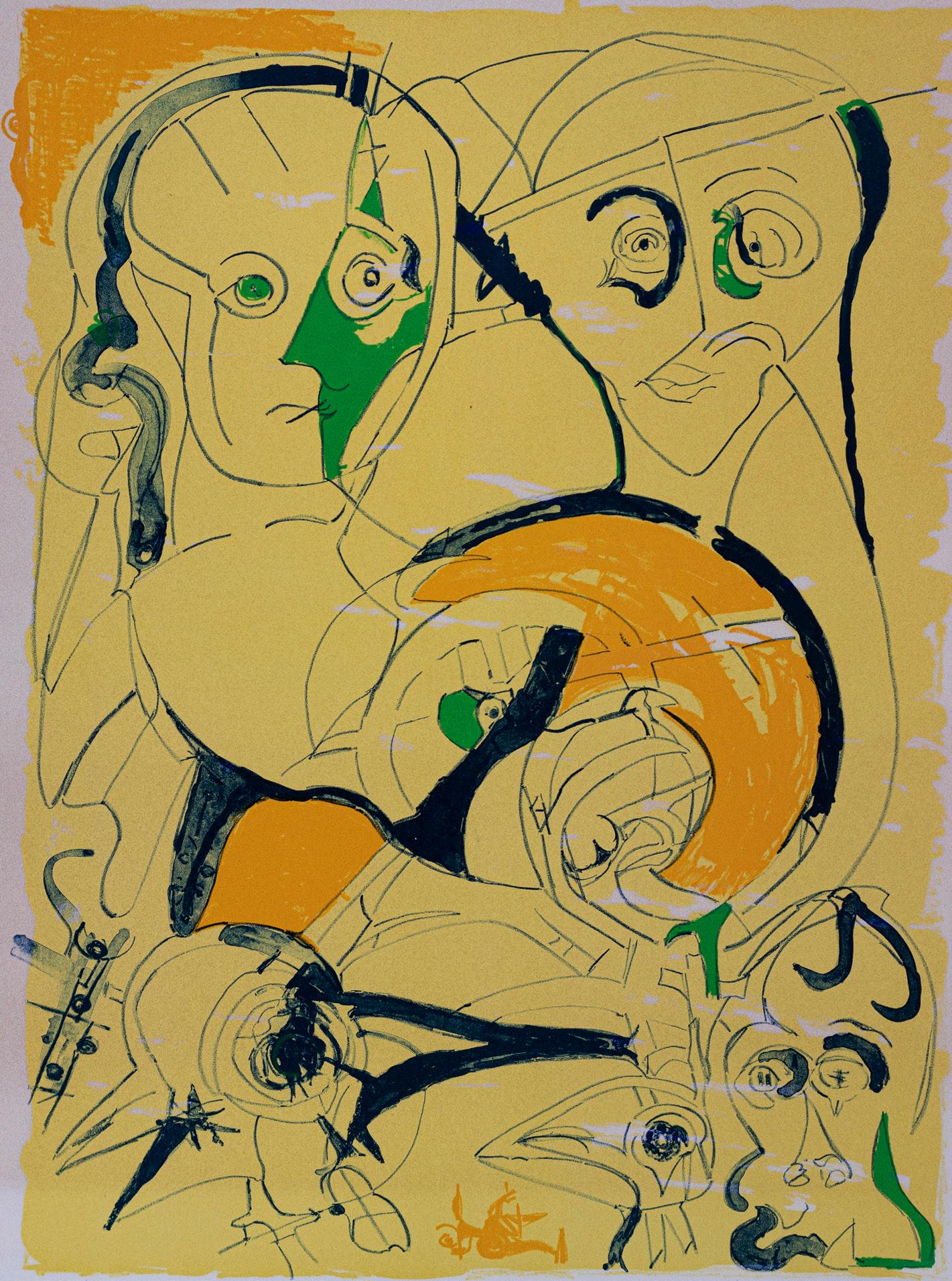
Sam Gilliam was born in Tupelo, Mississippi in 1933. Shortly after his birth, the family (Gilliam was one of eight children) moved to Louisville, KY where he was raised. Gilliam attended college at the University of Louisville, receiving a BFA in 1955. That same year his first solo exhibition was held at the university. He went on to serve in the Army and upon his return, began working towards his MFA.
After graduation, he taught for a year in the Louisville public schools until he moved to Washington D.C., where he continues to live today. Gilliam continued to teach in the Washington public schools as well as the Maryland Institute College of Art, University of Maryland and Carnegie Mellon University, Pittsburgh throughout his career.

By the time Gilliam arrived in Washington D.C. in 1962, the Washington Color School had been established and included Morris Louis, Kenneth Noland, and Thomas Downing. Gilliam met and became friends with Downing. Soon, his works became large, hard-edged abstractions. Everevolving, he continued to experiment with innovative methods - taping and pouring colors, folding and staining canvases. He
created beveled-edge paintings in which he stretched the canvas on a beveled frame, so that the painting appeared to emerge from the wall on which it was hung.
In 1965, he abandoned the frame and stretcher altogether and began draping and suspending his paint stained canvases much like hanging laundry on the clothesline. Each work could be improvised and rearranged at will. The first of these was displayed at the Corcoran Gallery of Art in 1969. Gilliam received numerous public and private commissions for his draped canvases. One of the largest of these was Seahorses in 1975. This six part work involved several hundred feet of paint stained canvas installed along the exterior walls of two adjacent wings of the Philadelphia Museum of Art. In 1972 he represented the US in the Venice Biennale.
By 1975, Gilliam began to create dynamic geometric collages influenced by Miles Davis and John Coltrane. In 1977, he produced similar collages in monochromatic black hues. Re-invention had been a consistent component in Gilliam’s work throughout his career - he constantly innovated, disrupted, and improvised and was still doing all of it until his death earlier this year.
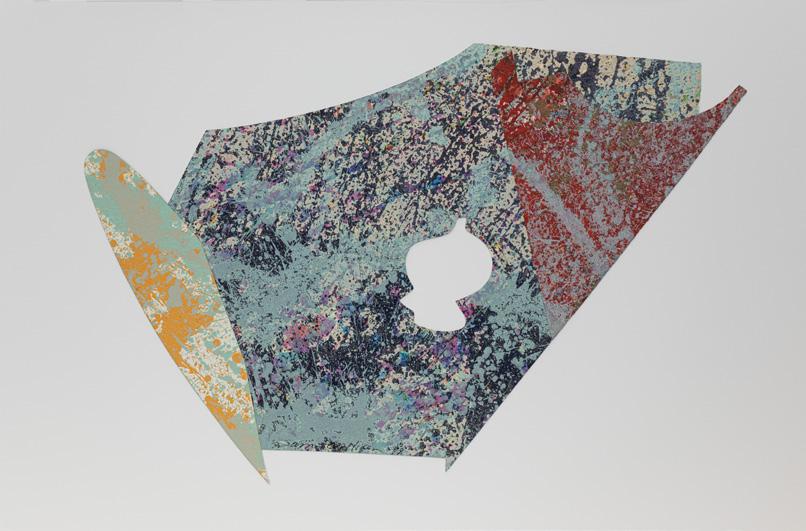
Gilliam’s work is found in the collections of the National Museum of African American History and Culture, Washington D.C.; Museum of Modern Art, NY; Metropolitan Museum of Art, NY; Tate Modern, London; and Los Angeles County Museum of Art, among many others.
Recent exhibitions include: Soul of a Nation: Art in the Age of Black Power
1963-1983; Black: Color, Material, Concept, Studio Museum in Harlem, New York, 2015; Surface Matters, Edward H. Linde Gallery, Museum of Fine Arts, Boston, 2015; Affecting Presence and the Pursuit of Delicious Experiences, the Menil Collection, Houston, 2015.
A semi-permanent installation of Gilliam’s paintings is currently on view at Dia: Beacon, NY.
Photo: Sam Gilliam photographed on June 22, 2016 in Washington, D.C. (Marvin Joseph, Washington Post)
188 Untitled, 1999 color and intaglio relief on hand made papers 16 x 23-1/4 inches signed and dated in ink Printed and published by Vermillion Limited Editions, Minneapolis. From the Platinum series.
$3,000
165 Untitled, 2008 acrylic and mixed media assemblage on panels 24 x 26 inches signed and dated verso (intentionally obscured by the artist) accompanied by a COA, letter from Andre "Mickey" Ferrell, former studio assistant of the artist, stating that this work was gifted to him by the artist.
$20,000

104 Untitled, Yellow, c. 2008 acrylic and collage elements on multi-layered panels 40-1/2 x 37 inches (irregularly shaped) unsigned accompanied by a COA, letter from Andre “Mickey” Ferrell, former studio assistant of the artist, stating that this work was gifted to him by the artist.
$25,000
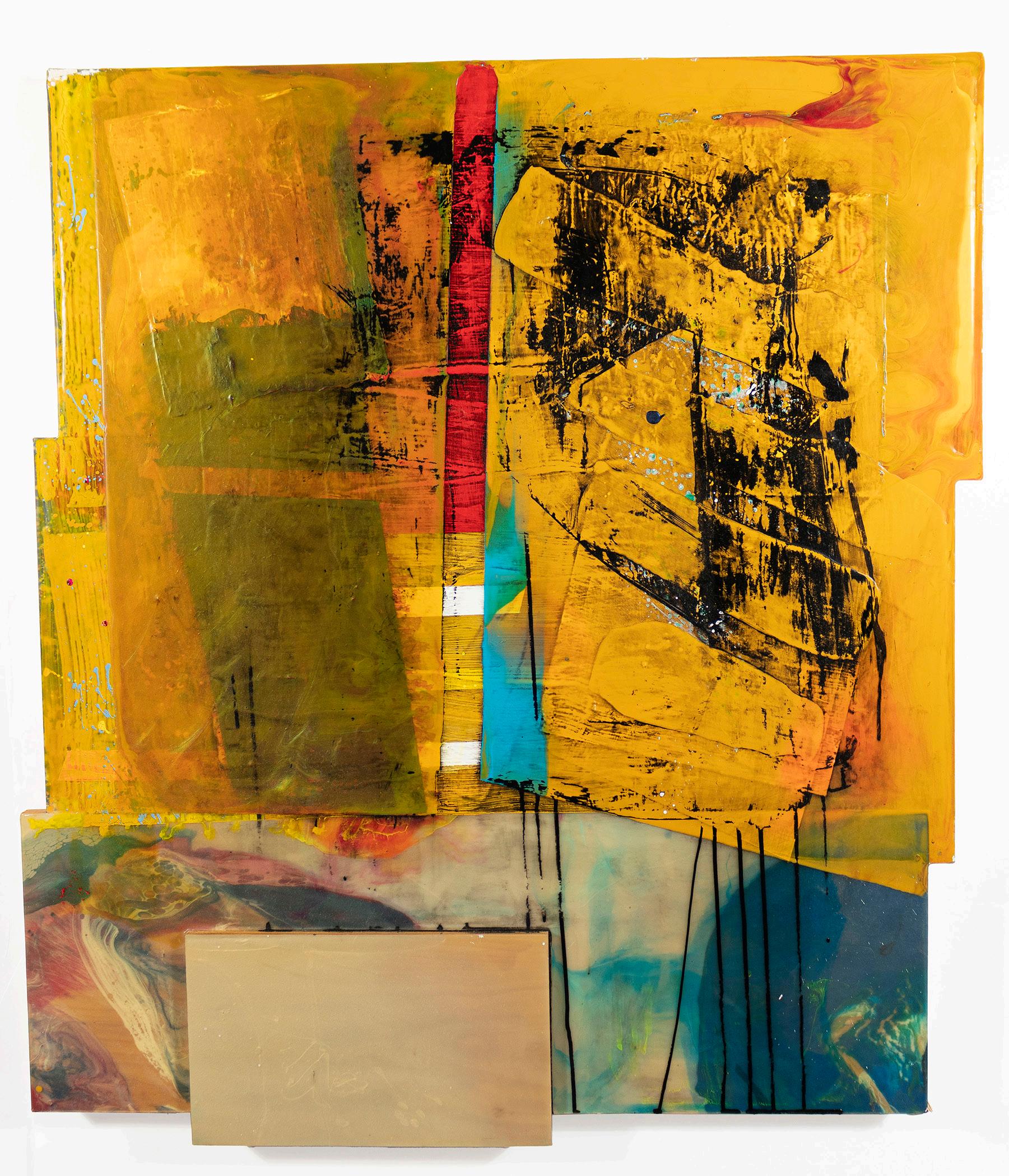
Painter, printmaker, and educator, Rex Goreleigh was born in Penllyn, Pennsylvania in 1902. At the age of eighteen, he moved to New York City where he began taking drawing classes while waiting tables to make ends meet. During one of his shifts, he happened to meet Diego Rivera, who invited him to watch him work on a mural he was painting at Rockefeller Center. After this, Goreleigh, who had previously been focused on a career in theater, decided to work in the visual arts. He received art instruction from the Art Students League in New York City, and in Paris, at L’Académie André L’Hote.
Under the auspices of the WPA, Goreleigh worked with Ben Shahn and taught at the Harlem Community Art Center - Jacob Lawrence and Robert Blackburn were among his students. He also established an artists community in Greensboro, North Carolina with Norman Lewis. In 1940, he and his wife re-located to Chicago where he served as director of the South Side Community Art Center. When his term ended, Goreleigh moved to New Jersey, be coming the director of the Princeton Group Arts from 1947 to 1953, and establishing a studio in a restored mill where he worked and taught classes.
Goreleigh’s work has been featured in the American Negro Exposition, 1940 as well as in exhibitions at the Harmon Foundation, NY, 1936; Pyramid Club, PA;, 1942; National Center of Afro-American Artists, Boston,1973; and the Studio Museum in Harlem, 1973, among others.
59 The Tobacco Series, 1973 lot of 8 paintings, oil on board 17-1/4 x 11 inches (image) all built into artist made frames which are, 29-3/4 x 23-3/4 inches, on plywood unsigned Princeton NJ (written on verso) $3,750
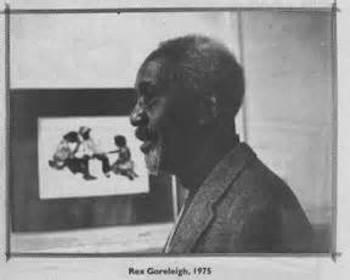
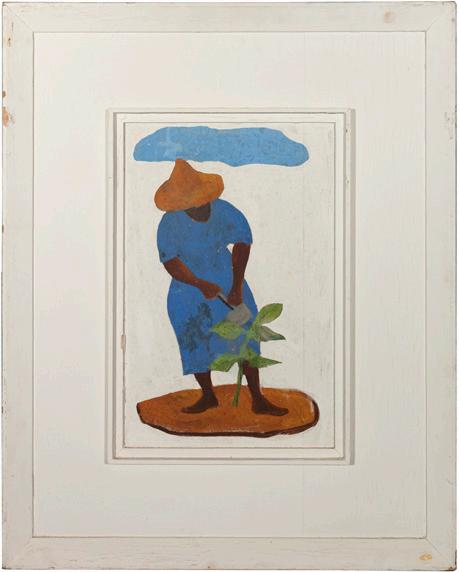
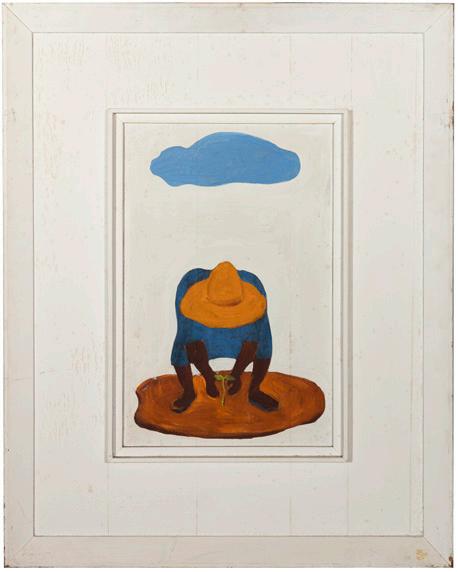
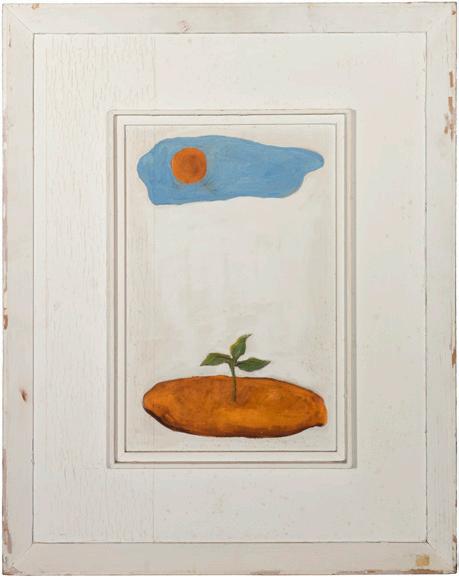
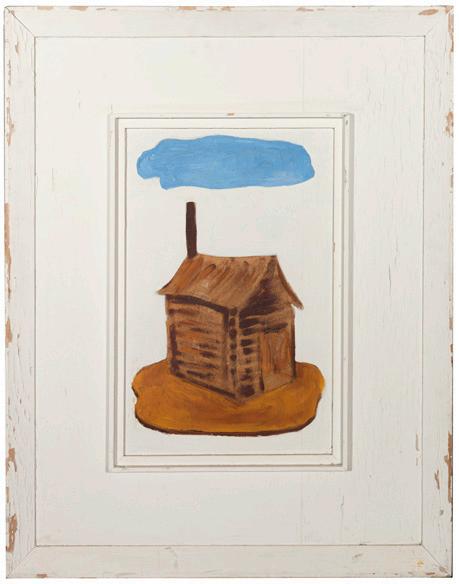
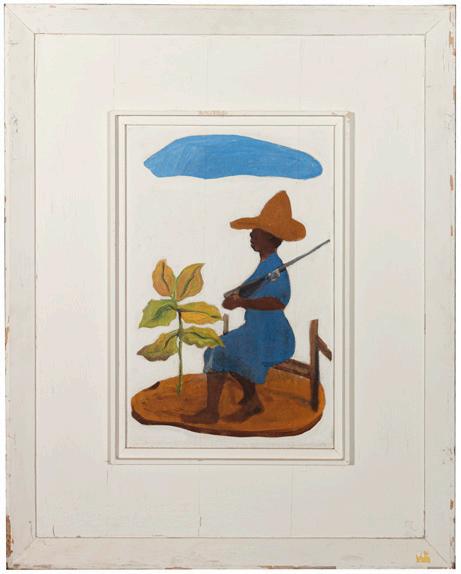
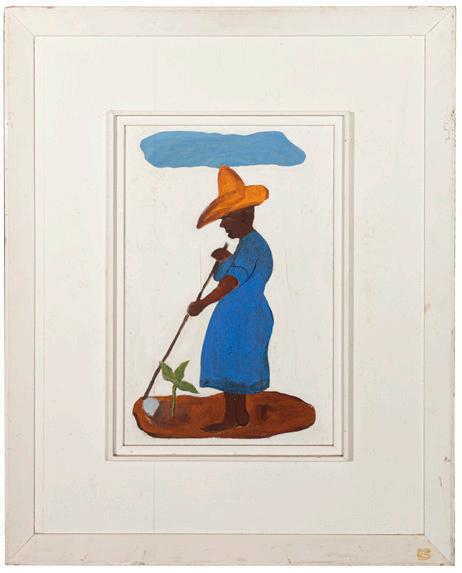
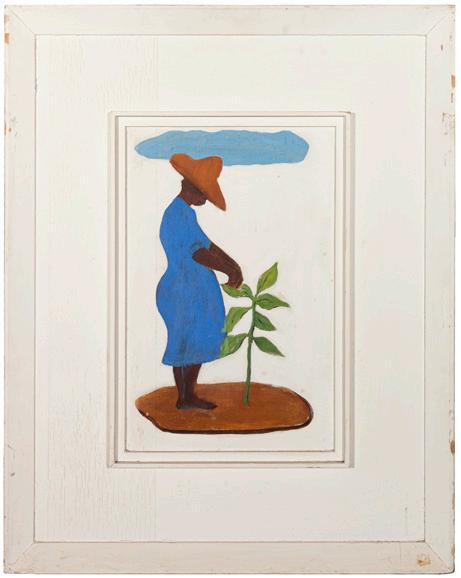
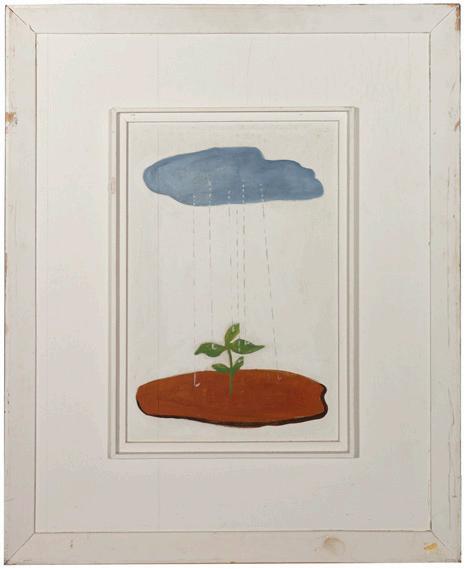
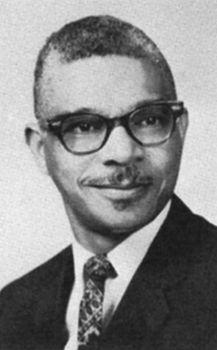
Painter and printmaker J. Eugene Grigsby was born in Greensboro,North Carolina. As a boy, growing up in Charlotte, North Carolina, he met self taught painter and stonemason, Walker Foster, who invited him into his studio. This chance meeting showed Grigsby that African Americans could pursue art and in doing so would empower himself and others. At Morehouse College, he studied under Hale Woodruff. Like so many young African American artists, Grigsby found in him a mentor, and a lasting influence on his work throughout his career. After graduating, he pursued a Master of Arts at Ohio State University and a Ph.D at New York University. His doctoral thesis was a comparative study of masks from the Northwest American Indian Kwakiutl Tribe and the Kuba tribe of the Belgian Congo.
Early in his career, Grisby was known for creating scenes in oil or acrylics and woodcuts, lithographs and serigraphs that reflected his interest in depicting scenes of the everyday African American life. As the events of the 1960’s unfolded, he was inspired to create more socially conscious art that reflected the struggles and triumphs of African Americans in resisting racism and oppression. By 1972, Grigsby had been working as a visiting lecturer in Africa, and his work incorporated African themes.
Grigsby is internationally recognized as an educator and writer. In 1977, he wrote the text, Art and Ethnics: Background for Teaching Youth in a Pluralistic Society, featuring the visual arts of African Americans,
American Indians, and Latinos. It is highly regarded by both scholars and artists as a definitive work of the late 20th century. A revised edition was completed in 1997 which included Asian American visual art.
Grigsby continued to produce and show his work until his death in 2013. In 2001 a major retrospective of his work, The Art of Eugene Grigsby, Jr.: A Sixty-Five Year Retrospective, was held at the Phoenix Art Museum. In 2014, the Harvey B. Gantt Center for African American Arts and Culture in Charlotte, North Carolina held the exhibition, Selected Works of J. Eugene Grigsby, Jr.: Returning to Where the Artistic Seed was Planted, which showcased 30 works of art that spanned his entire career. His work may be found in the collections of Arizona State University Art Museum, Tempe; Delta Art Center, Winston-Salem, North Carolina; Malcolm X College, Chicago; Milwaukee Art Museum, Wisconsin; and Ohio State University, Columbus Ohio.
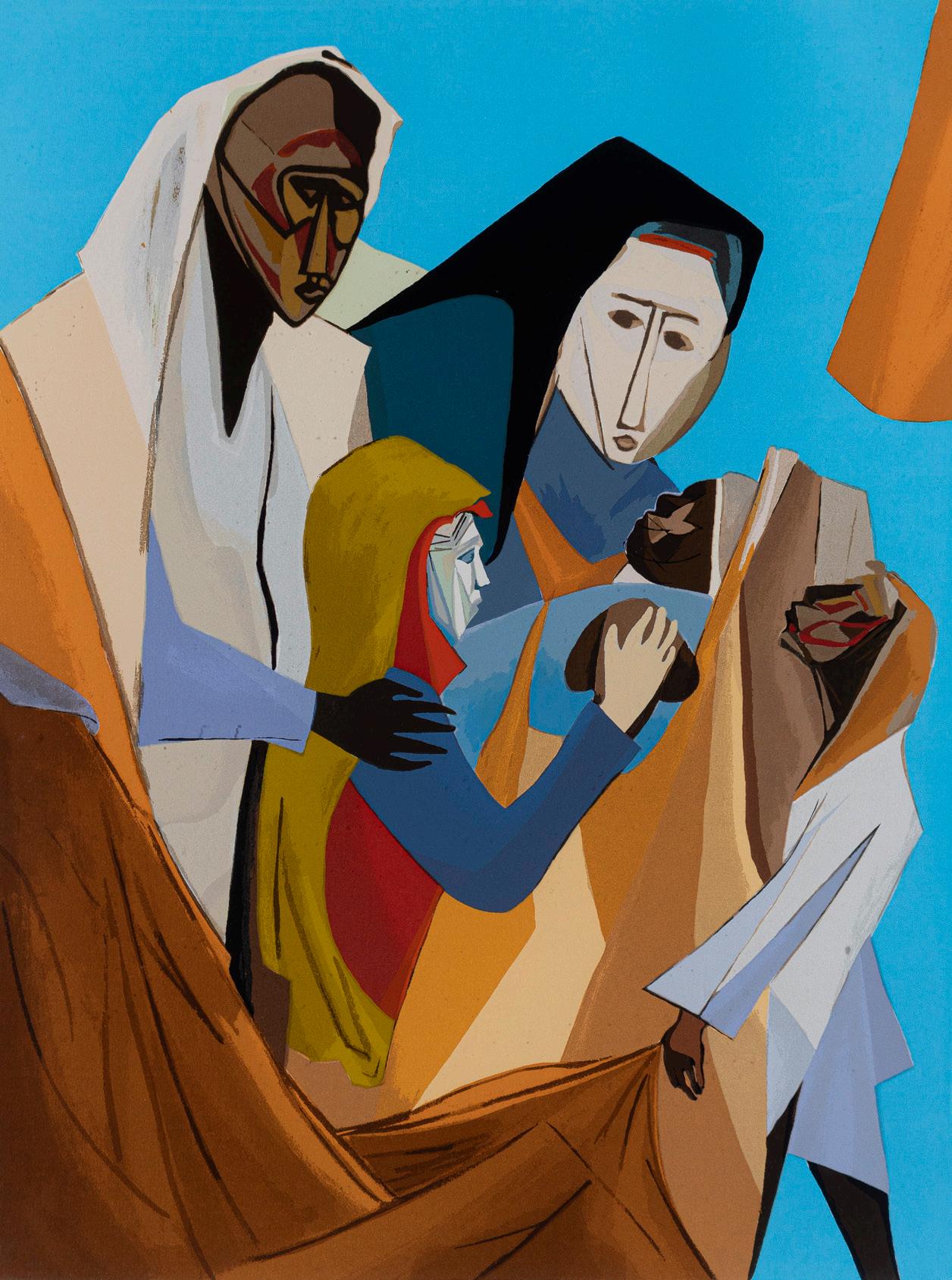
John Hardrick was born in Indianapolis to Shepard and Georgia Etta (West) Hardrick in 1891. He showed a talent for art as a young boy, and his work was brought to the attention of the owner of a local art store and framer, Herman Lieber, who helped the boy enroll in children’s classes at the John Herron School of Art (interestingly, many of the frames one will find on his paintings today were made by Lieber and bear the label).
As a teenager, he began studying with important Hoosier Group impressionist painters, William Forsyth and Otto Stark. He worked at a foundry at night to put himself through John Herron (he executed a well known painting of this subject matter, illustrated in the catalog for the exhibition, A Shared Heritage, Art by Four African Americans (Hardrick, Scott, Woodruff, and Majors), IMA, Warkel and Taylor, p. 59).
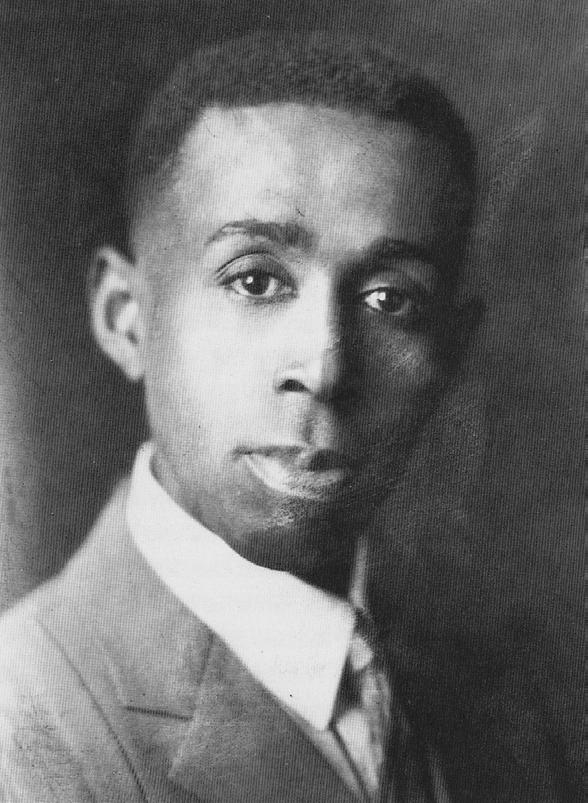
In 1914, he was married to Georgia Ann Howard and held his first exhibition, which was successful. He shared a studio on Indiana Avenue with Hale Woodruff for some of that year, but increased financial pressures caused him to stop painting, and take a job in his family’s trucking business.
When he resumed painting, he exhibited at the Art Institute of Chicago in
1927. One of his paintings, Little Brown Girl was purchased by a group of supportive black citizens and donated to the Herron Art Institute for their permanent collection. It currently hangs at the Indianapolis Museum of Art. He exhibited at the 2nd Annual Exhibition of Contemporary Negro Art in San Diego in 1928, and the catalog read: “In spite of acute poverty, this young man has the faculty of discerning beauty in everything, being able to face all his adversities with a smile that conceals the feeling within, at the same time he possesses a personality which strangely draws people to him.”
He also exhibited at the Hoosier Salon in
1929, 1931,and 1934, which were then held in Chicago at Marshall Field and Company. He won first prize for a portrait at the Indiana State Fair in 1934. He participated in the American Negro Exposition in Chicago, 1940.
The Civil Works Administration commissioned him to do a mural at the Crispus Attucks High School (the school where Irvena, the subject of this work, attended) in 1934, but it was rejected by the principal because it depicted black foundry workers, not doctors and lawyers.
Hardrick’s health declined by 1941, and he worked as a cab driver. He would keep supplies in the trunk of his cab, and while waiting for fares, quickly paint local street scenes; later, he would also offer the paintings for sale from the trunk of his cab. (REF: Tom Davis, research for the Crown Hill Cemetery, Indianapolis)
Hardrick’s landscapes are derived from the many trips he took to Brown County, about fifty miles from Indianapolis. He traveled to the area at the peak of the autumn season,
when the leaves were at the height of their color; during the summer when the sun was bright and hot; and in the winter when the ground was covered with snow. He did not sketch or paint during these visits . Instead, the artist took in the different scenes and committed them to memory. (REF: A Shared Heritage, Art by Four African Americans, IMA, Warkel and Taylor, p. 41).
He applied his paint very thickly, using a palette knife to create a tactile surface. He relied on a brush only to blend or add a shape, and use his thumb to mold the paint as if he were shaping a sculpture. (Ibid, p. 41) Hardrick worked quickly, beginning at the top of the canvas and working down. He was more concerned with the atmosphere and expression of the landscape than the descriptive qualities, thus following in the tradition of earlier African American landscape painters, Bannister and Duncanson. His landscapes were romanticized versions of his memories of his visits to the country. He blended his own paint when possible, and has a very distinctive palette.
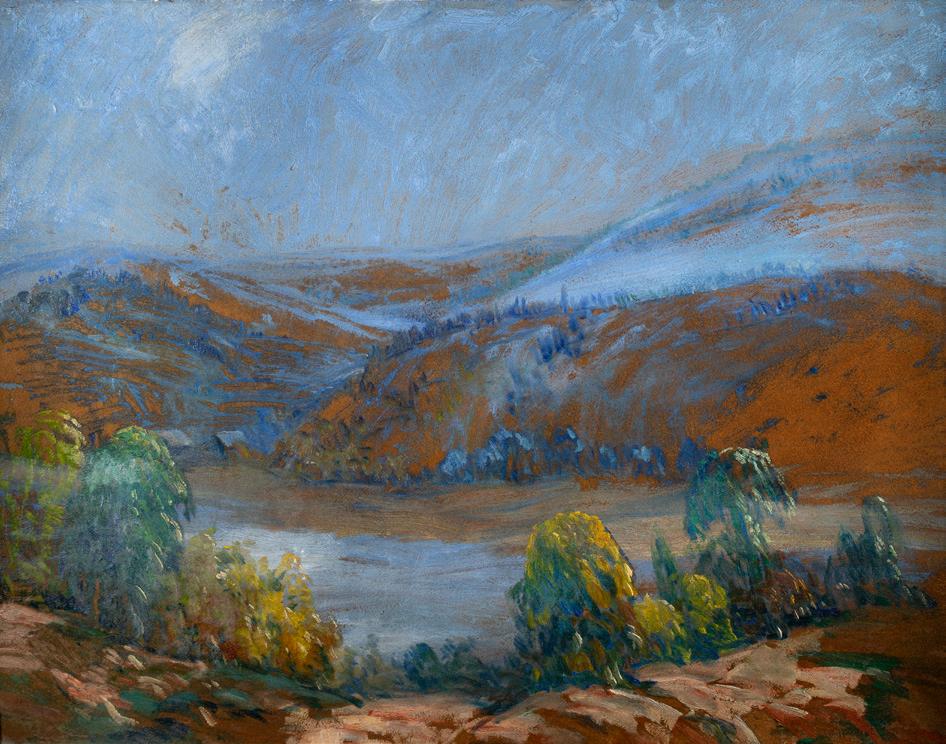
12 Bus in a Snow Storm, Indianapolis, c. 1935 Oil on board 20 x 24 inches
Signed
Illustrated and Exhibited: A Shared Heritage, Art by Four African Americans (Indianapolis Museum of Art), 1996. p. 58
Provenance: Collection of George and Terry Gray, Chicago, IL.
Harriet G. Warkel writes in A Shared Heritage, Art by Four African Americans: “Bus in a Snow Storm” (fig. 36) depicts a group of people bracing themselves against the cold as they board a bus. Heavy snow obliterates the landscape, leav ing no discernible landmarks. The artist renders figures using only a few strokes of the brush, and thus concentrates on gestures rather than features. Hardrick contrasts the blowing snow with the warm, yellow light emanating from the interior of the bus, a haven for the traveler on a cold, wintry day. The prominent figure is a black man, separated from the rest of the crowd, battling the blowing snow. He may be the artist’s symbol of the African American’s struggle against a hostile world. Hardrick rarely ventured into the realm of social realist art, but when he did paint in this genre, his statements were subtle not overt. “ (p. 50)
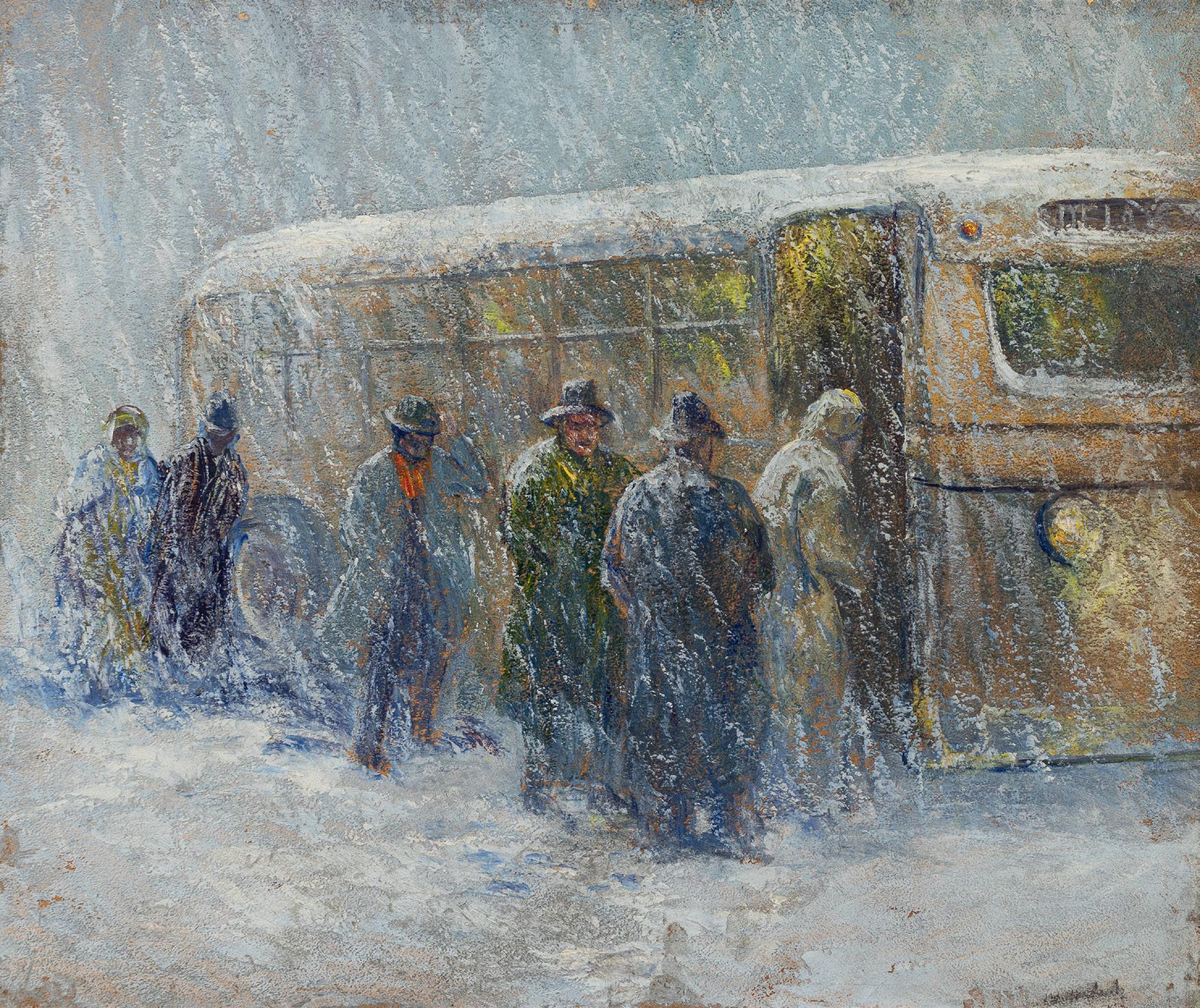
William Henry Johnson was born in Florence, South Carolina in 1901. His mother, Alice Johnson, was of African American and Native American ancestry and his father (who was not married to his mother) was white. Alice soon married a local African American man and they had four additional children. William was interested in drawing at an early age, copying cartoon characters. When he was 18, he dropped out of school and accompanied his uncle to New York in search of better job opportunities. Two years later, when he was 20 years old, he had saved enough money to enroll at the National Academy of Design to study art. Johnson showed tremendous promise at the NAD and came to the attention of two well-respected painters, Charles Hawthorne and George Luks. They mentored him and raised enough money forJohnson to travel to Paris. Hawthorne suggested Johnson might have more success as a black artist in Europe initially, and upon proving himself there, possibly return to the States.
One of Johnson’s greatest influences in France was the work of Chaim Soutine. Soutine’s paintings were a step further than the Ashcan style works of Luks; they were Expressionist, and full of energy and emotion. Landscapes, seascapes and buildings were frenzied, distorted and thickly painted. Johnson moved to the South of France to Cagnes-sur-Mer, where
Soutine had worked. This work shares two very obvious characteristics with the work of Soutine: the red/pink palette and the “accordion-like” composition of trees and buildings.
In 1929, Johnson met a Danish tapestry weaver and ceramicist named Holcha Krake. Holcha and her sister and brother-in-law were preparing to tour Europe’s museums and art centers, and invited William to come along. Eventually, the group returned to Holcha’s home of Odense, Denmark. Johnson married Holcha in 1930, and they lived in Kerteminde, a Danish fishing village.
Johnson admired the woodcut prints made by the Expressionists, especially the German, Max Beckmann, and the Norwegian, Edvard Munch, and this work reveals the influence of artists such as these on not only Johnson’s style, but also his choice of medium. Johnson met Munch in 1932, introduced by Pola Gauguin, the son of painter Paul Gauguin.
In 1929, Johnson had returned to New York to exhibit in the Harmon Foundation show of 1930, in which he was awarded the gold prize. He returned to the United States with Holcha in 1938, planning to make the U.S. his permanent residence. He felt a need to succeed in his home country. This was a difficult time in the
United States, and Johnson had no luck selling his work. He eventually got a job through the W.P.A. teaching at the Harlem Community Art Center. Johnson became enamored with the work of Horace Pippin and Jacob Lawrence and decided to change his style to what he called “primitive” (he had actually deemed himself a “primitive” earlier in his career, influenced by Paul Gauguin’s adoption of the term as a mindset—not a style of painting). Johnson’s new style embraced simplicity, and his subjects were calm and self-assured of their identity. He enjoyed his most productive period from 1939 through the mid 1940s. In 1943, Holcha died of breast cancer, and Johnson returned to Florence. He painted portraits and local scenes in his new style, but succumbed to grief about losing Holcha. In his devastated state, he developed a plan to return to Denmark to marry Holcha’s sister, Musse, whom he had met in 1929. His proposal was rejected by Musse, but he remained with the Krake family for six months. He then moved to Oslo with the intention to exhibit his work there, but was in a state of declined mental health and was found wandering the streets. He was taken in by the Traveler’s Aid Society and shipped back to New York, where he was admitted to a state hospital in 1947. He remained there until his death in 1970, unable to recognize anyone and unable to paint.
H. Johnson at easel, c. 1930; William H. Johnson: An American Modern, Teresa G. Gionis, 2011; p.104

38 Landscape With Sunrise, c. 1944-1947 oil on cardboard book 7 x 10-1/2 inches signed; marked with estate stamp from Tilhorer Niels Lindberg
Provenance: Niels Lindberg, to private collection, Copenhagen, Denmark. $12,500


47 Sojourner Truth, c. 1942 plaster with painted bronze patina 9-1/2 x 8-1/4 x 4 inches title incised in plaster, lower front edge; initialed and incised, “1797-1883” and artist’s initials lower back edge.
Provenance: private collection, Illinois to private collection, Michigan. $4,000
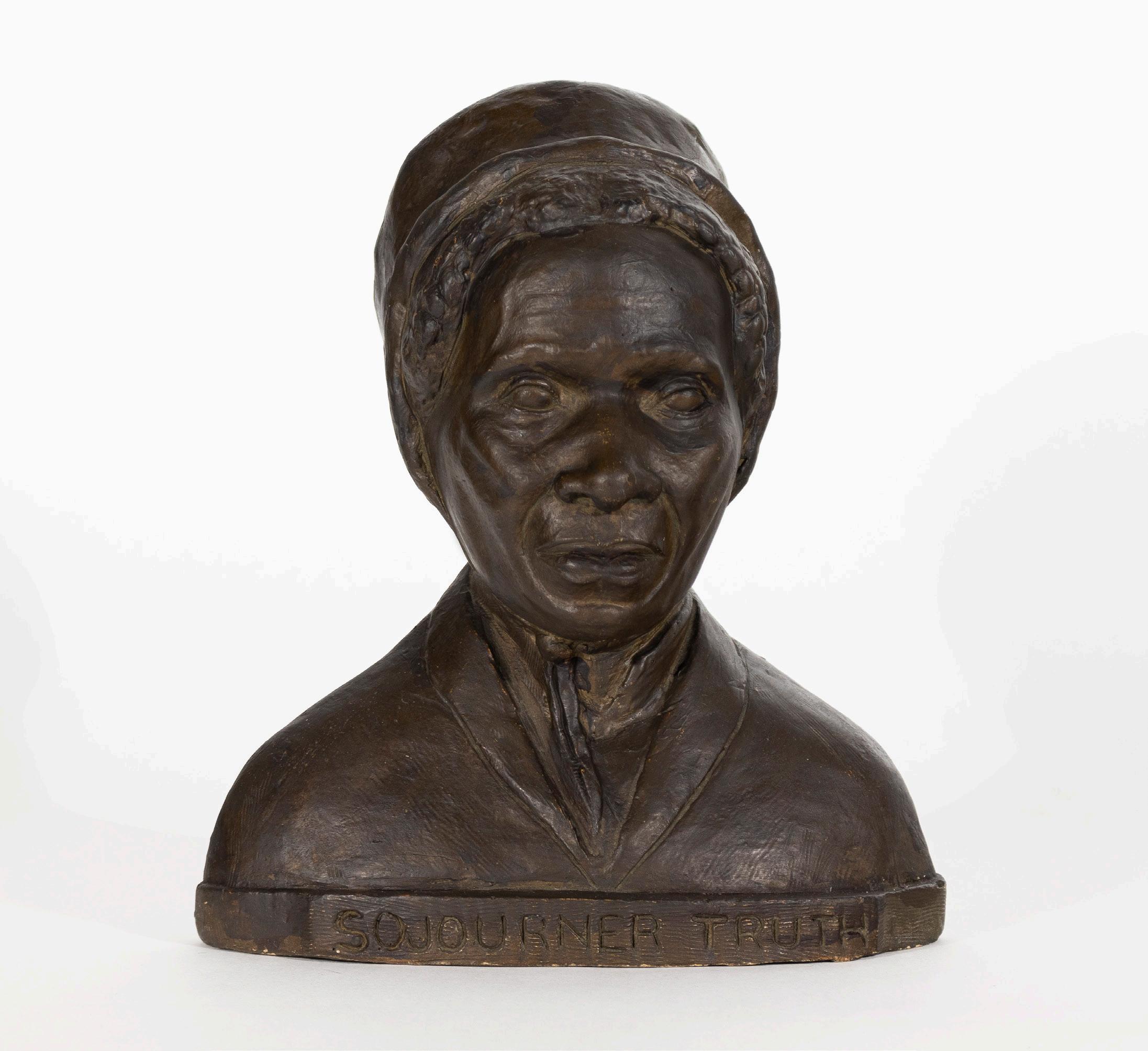
Jacob Lawrence was born in Atlantic City, New Jersey in 1917 and raised in Philadelphia and Harlem. As a teenager, Lawrence had been uprooted from a childhood spent in Philadelphia when his mother brought her children to live with her in Harlem. She enrolled him in the after-school arts program directed by James Lesesne Wells. Lawrence’s mentor happened to be Charles Alston. He was able to create voraciously - he created elaborate paper mâché masks and threedimensional models of Harlem. He read about master painters and focused his attention on patterns and colors.

Lawrence began attending high school, but quit after two years, worked odd jobs, and completed a stint with the CCC digging ditches during the Depression. He rediscovered Alston who was now teaching in a WPA art center. Alston directed him to the Harlem Community Art Center, which was run by Augusta Savage. She was able to get him admitted as an easel painter by the time he turned 21. He eventually found studio space with fellow artists Ronald Joseph, Romare Bearden, and Claude McKay. Lawrence was a regular at Professor Charles Seifert’s discussions of African and African American history at the 135th St. branch of the NYPL. At Seifert’s request, he attended an exhibition of West African sculpture at the Museum of Modern Art.
As an artist, Lawrence synthesized the events, meetings, discussions, experiences,
and moments of his life onto the canvas and into his first narrative series (and the works to come). In 1936-38, he produced a series of works, The Life of Toussaint L’Ouverture. For him, it was not sufficient to produce one defining work on the life of such an important historical figure, so he created 41 paintings. Lawrence also created series on Frederick Douglass in 1939; Harriet Tubman, 1940; John Brown; and the Migration Series.
In 1939 the James Weldon Johnson Literary Guild sponsored an exhibition of his work at the Harlem YMCA - his first publicized one man show. The Toussaint L’Ouverture series was also shown at the Manhattan headquarters of the Catholic Interracial Council. Later, an entire room was set aside at the Baltimore Museum of Art for his series. This was unprecedented. Lawrence was well on his way to becoming the best known African American artist of his time.
Lawrence won three successive Rosenwald Fellowships. With the second, he traveled through the South, experiencing both rural and urban life, the result of which was his Migration Series. It was at this time that Edith Halpert of the Downtown Gallery began representing him. During WWII, he served in the Coast Guard, and was assigned to the first racially integrated ship in US history. In 1946, he accepted an invitation from Josef Albers to teach at Black Mountain College in North Carolina. He taught at many schools throughout his career, including the Art Students League, New School for Social Research, Pratt Institute and the University of Washington in Seattle, where he eventually retired.
Between 1986 and 1997, Lawrence created prints from The Life of Toussaint L’Ouverture Series, which is now in the collection of the Amistad Research Center at Tulane University in New Orleans. Lawrence translated 15 of these paintings into silk screen prints. At this later date, he was able change certain aspects of the work when adapting his original paintings to sets of
silkscreen prints. The works were shown in the exhibition, To Preserve Their Freedom: Jacob Lawrence’s Toussaint L’Ouverture Serigraph Series, held at the Amistad Research Center, New Orleans in 2017.
Recently, his work has been shown in Historical and Contemporary Perspectives on Jacob Lawrence and Black Mountain College, Black Mountain College Museum & Art Center, Asheville, NC, 2018-19 and I, Too, Sing America, Columbus Museum of Art, OH, 201819. The exhibition, Jacob Lawrence: The American Struggle, was held at the Peabody Essex Museum, Salem, MA and the Metropolitan Museum of Art, NY in 2020.
His work is found in the collections of MOMA, NY; National Academy of Design, NY; National Gallery, Washington D.C.; The Phillips Collection, Washington D.C.; the Museum of Fine Arts, Boston; and many more.

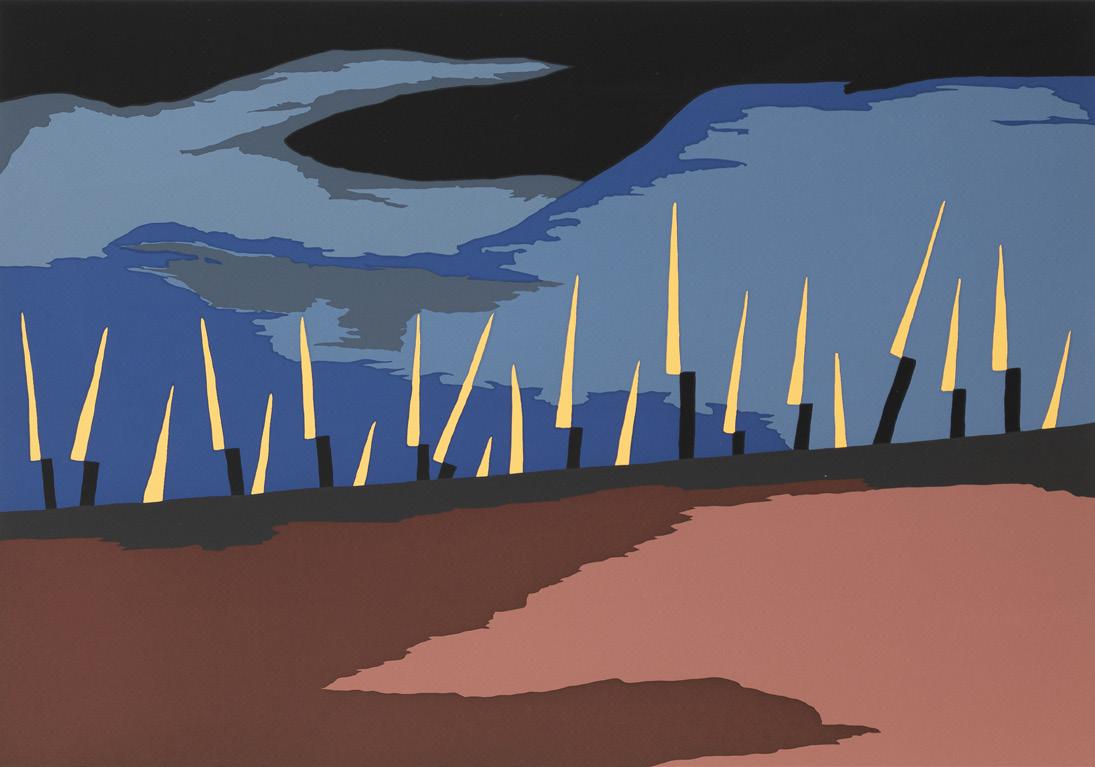
24 Flotilla, 1996
color screenprint on Rising Two-Ply Rag paper
18-3/8 x 28-7/8 inches (image) 22-1/4 x 32-1/4 inches (sheet) signed, titled, dated, and numbered 70/120 L96-6 This print is based on the thirty-first image from the original series of 41 paintings of The Life of Toussaint L' Ouverture. (Nesbett, 82)
$4,250
201 The Opener, 1997
18-3/4 x 28-3/4 inches (image) 22-1/4 x 32-1/8 inches (sheet) signed, titled, dated, and numbered 11/125 L97-5
$6,000
46 New York in Transit I, 1998 silkscreen on Rising Two Ply Rag paper through hand cut film stencils edition of 50 with 5 AP, 4 PP, and 1 HC screens destroyed 12 x 36 inches (image) 20 x 40-1/8 inches (sheet) signed, titled, dated, and numbered
Published by the Jacob Lawrence Catalog Raisonné Project, Seattle. Printed by Workshop, Inc. Washington DC, Lou Stovall (master printer)
This image is based on the maquette for a mural by the artist titled New York in Transit (1997), owned by the New York Metropolitan Transit Authority. Published to provide research and publication funding for a cata logue raisonné on Lawrence’s paintings, drawings, and murals.
$11,000

Lofton studied with John Biggers at Texas Southern University (Houston) and Clarence Talley at Prairie View A&M University (Prairie View). He has exhibited extensively from the 1980s to present, including at the Houston Art League; Museum of Science and Industry, Chicago; Traveling Exhibition of Works by Texas Printmakers, 1995; African American Museum, Dallas, TX; Amon Carter Museum; Kinsey Collection Art Exhibition, Houston Museum of African American Culture; The Harmon and Harriet Kelley Collection: Works on Paper, Houston Museum of African American Culture.
Photo: Studios and Workspaces of Black American Artists, Forbes, 2008, p. 298.
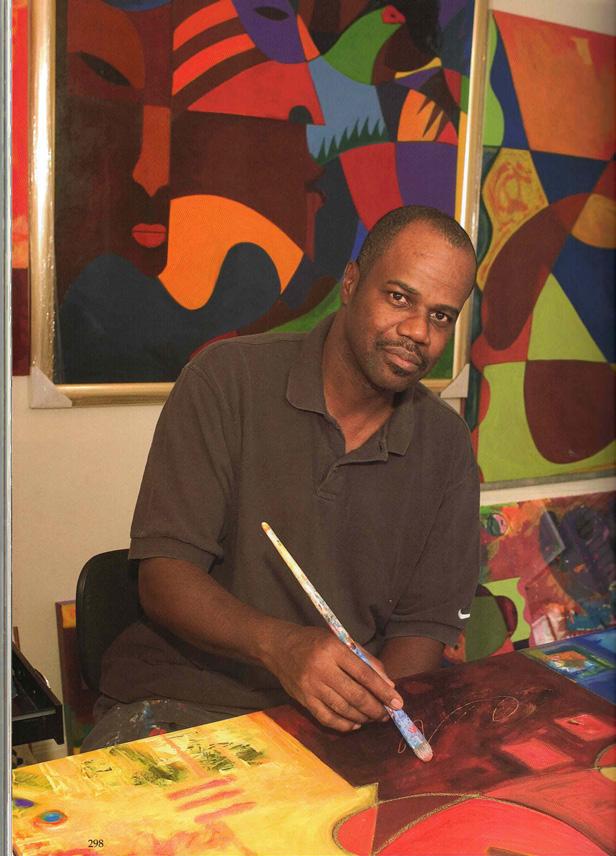
124 Burnt Toast, 2022 acrylic and collage on canvas 36 x 48 inches signed, titled and dated $3,500

44 Wilmington, Delaware, c. 1947 oil on canvas 24 x 30 inches signed; dated on stretcher, verso $7,000

125 Untitled, NY Series, c. 1968-1969 oil on canvas 52 x 60 inches estate stamp; authenticated by Susan Stedman, the widow of the artist Provenance: the estate of the artist $45,000

Mayhew was born in 1924 to parents of African American and Native American descent. He was educated at the Art Students League, NY; Brooklyn Museum Art School; and Pratt University, as well as receiving a degree in art history at Columbia University, NY. During this time, he studied under Edwin Dickinson, Reuben Tam, Hans Hofmann, and Max Beckmann. Mayhew was one of the founding members of the group Spiral, formed in 1963 by Romare Bearden, Norman Lewis, and Hale Woodruff and worked to address issues of civil rights and racial inequality through art.
Mayhew’s first solo exhibition was held at the Brooklyn Museum in 1955 with a second solo exhibition held in 1957 at Morris Gallery, NY, both of which met with much critical success. His work has also been exhibited at the Studio Museum in Harlem; San Jose Museum of Art, CA; Butler Institute of American Art, OH; High Museum of Art GA; and Boston Museum of Fine Arts. In 2009, a retrospective of his work including paintings from the 1950’s through the 1970’s was held at the Museum of the African Diaspora, San Francisco, CA.
His work is found in the collections of Albion College, Michigan; Brooklyn Museum, NY; Evansville Museum, IN; Midtown Galleries, NY; and the Whitney Museum of American Art, NY.
Photo: The artist, ca 1979; The Art of Richard Mayhew, Museum of the African Diaspora, 2009.
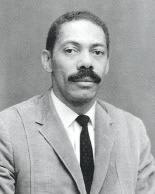
170 Summation, 2013 serigraph on unique hand-made paper 32 x 44 inches (image) 40 x 50 (sheet) signed, titled, dated, WP (edition of 150) $7,000
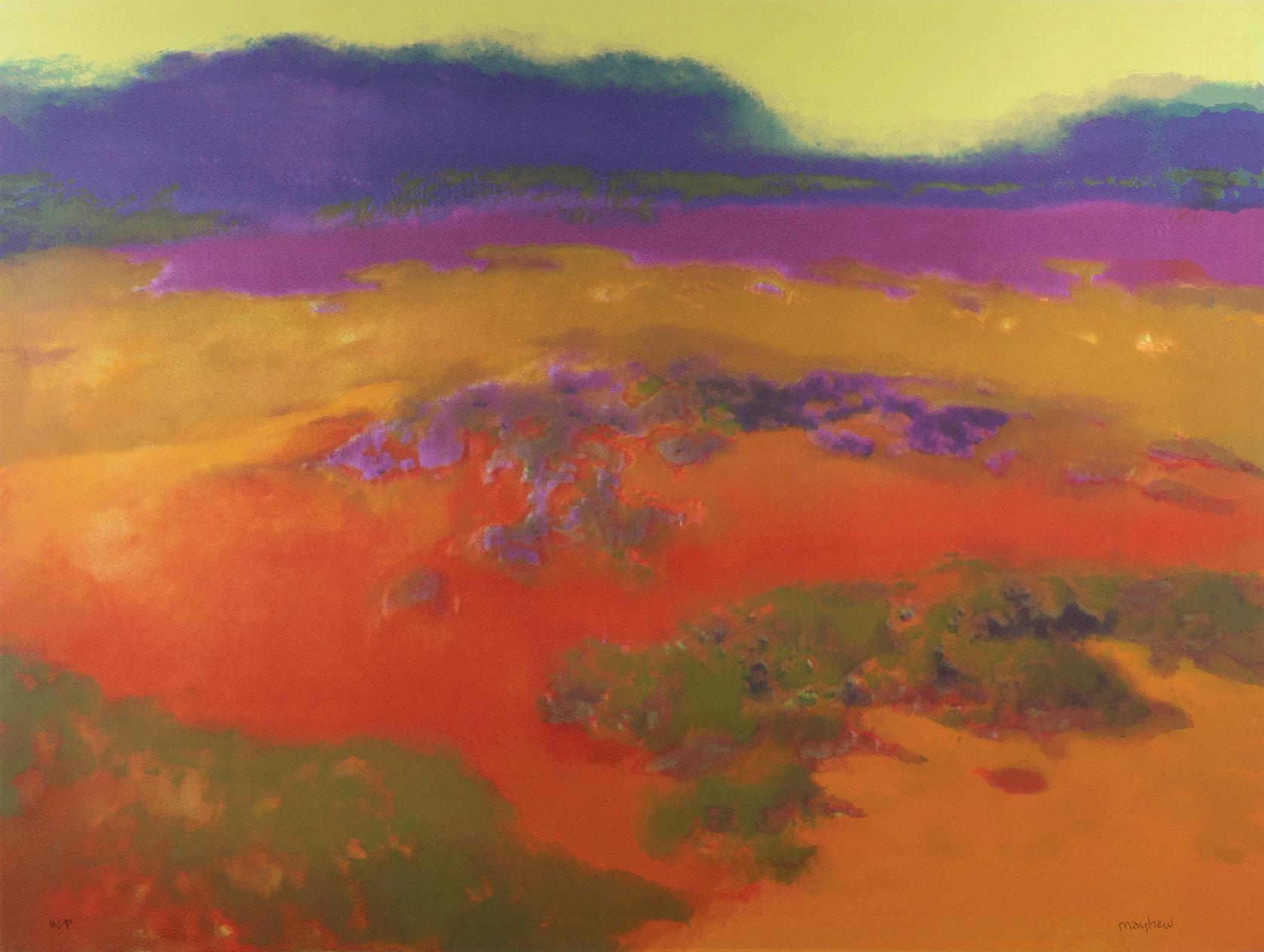
(1917-2005 )
119 Stage Struck, c. 1989 graphite, gouache and marker on brown wove paper 7-1/4 x 5-1/4 inches signed and titled artist’s ink stamp verso: Rose Piper, 250 W. 94th St., Apt 7G, New York, NY 10025 $3,000
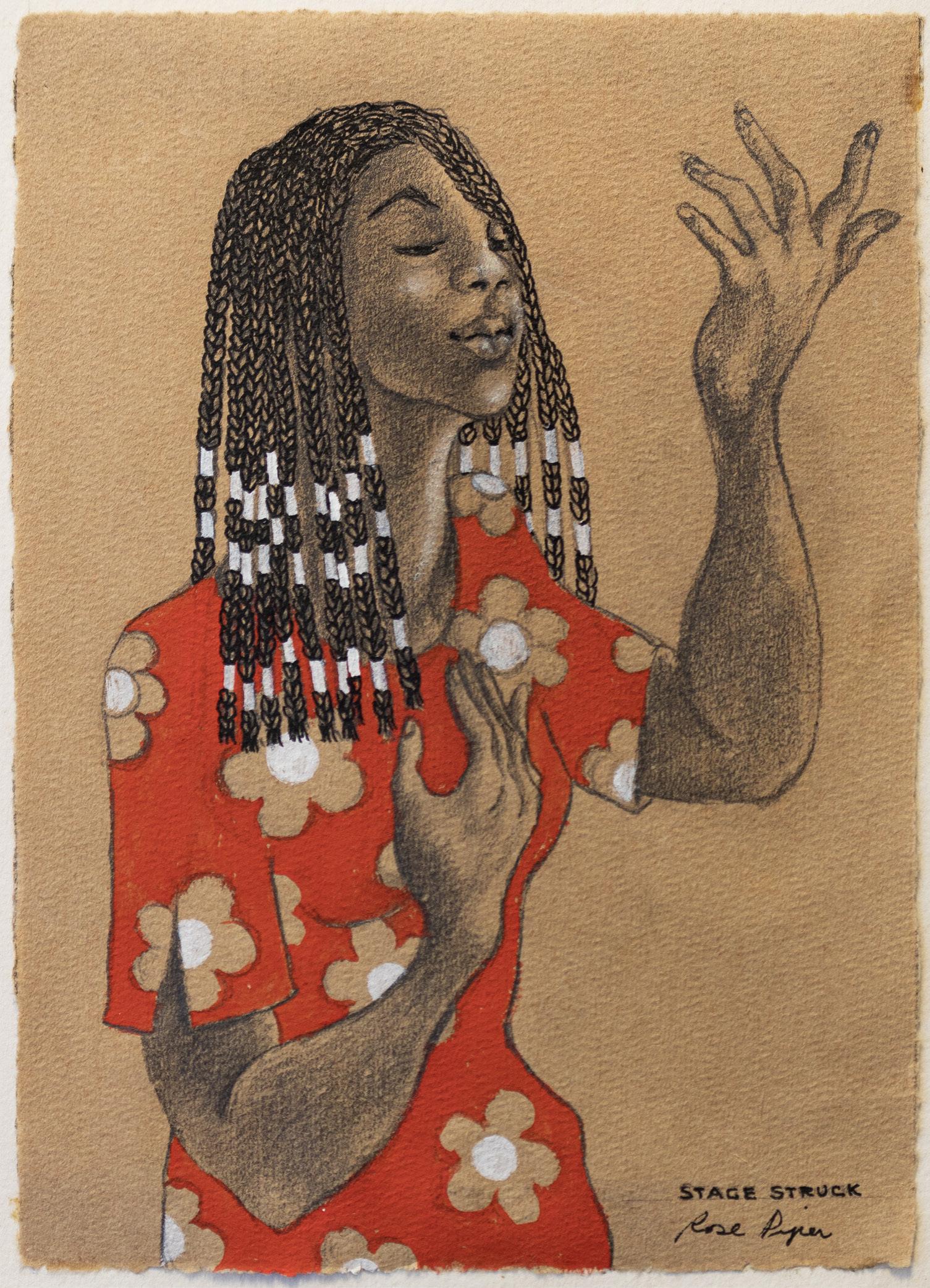
Joe Selby was born in Mobile, Alabama. He painted in Miami, Florida from the 1920s to the 1950s. As a boy he worked as a deck hand on tugboats; in 1905 at age twelve he was involved in a tragic accident when his leg was mangled in a line-handling accident. The accident ended his career as a deckhand, so Selby turned to painting ship portraits.
He painted all types of boats, but primarily yachts, approaching owners at the Miami city pier to ask if they wanted a portrait of their boat. If the owner agreed, Selby boarded the vessel to take notes and make measurements, then returned to a fire station near the dock where he would commence on the portrait. Early in his painting career (1920s-30s), Selby worked in Baltimore and painted boats on the Chesapeake Bay.
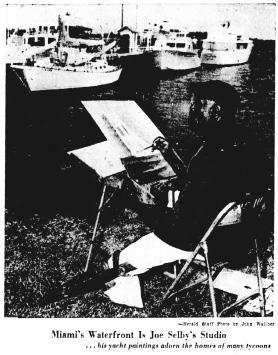
Over the years his clients included General Motors magnates Alfred P. Sloan and Charles Kettering, Axel Wennegren, Arthur James Curtis, William B. Leeds, and members of the Morgan and Rockefeller families.
Selby lived much of his life in public housing in Miami's Overtown district before constructing his own home. His last dated painting was in 1959. His work is in the collection of the Chesapeake Bay Maritime Museum, St Michaels, MD. REF: Roger King Fine Art
A short film about the work of Joe Selby.
Photo: Miami Herald, Feb 21, 1959, p. 29.
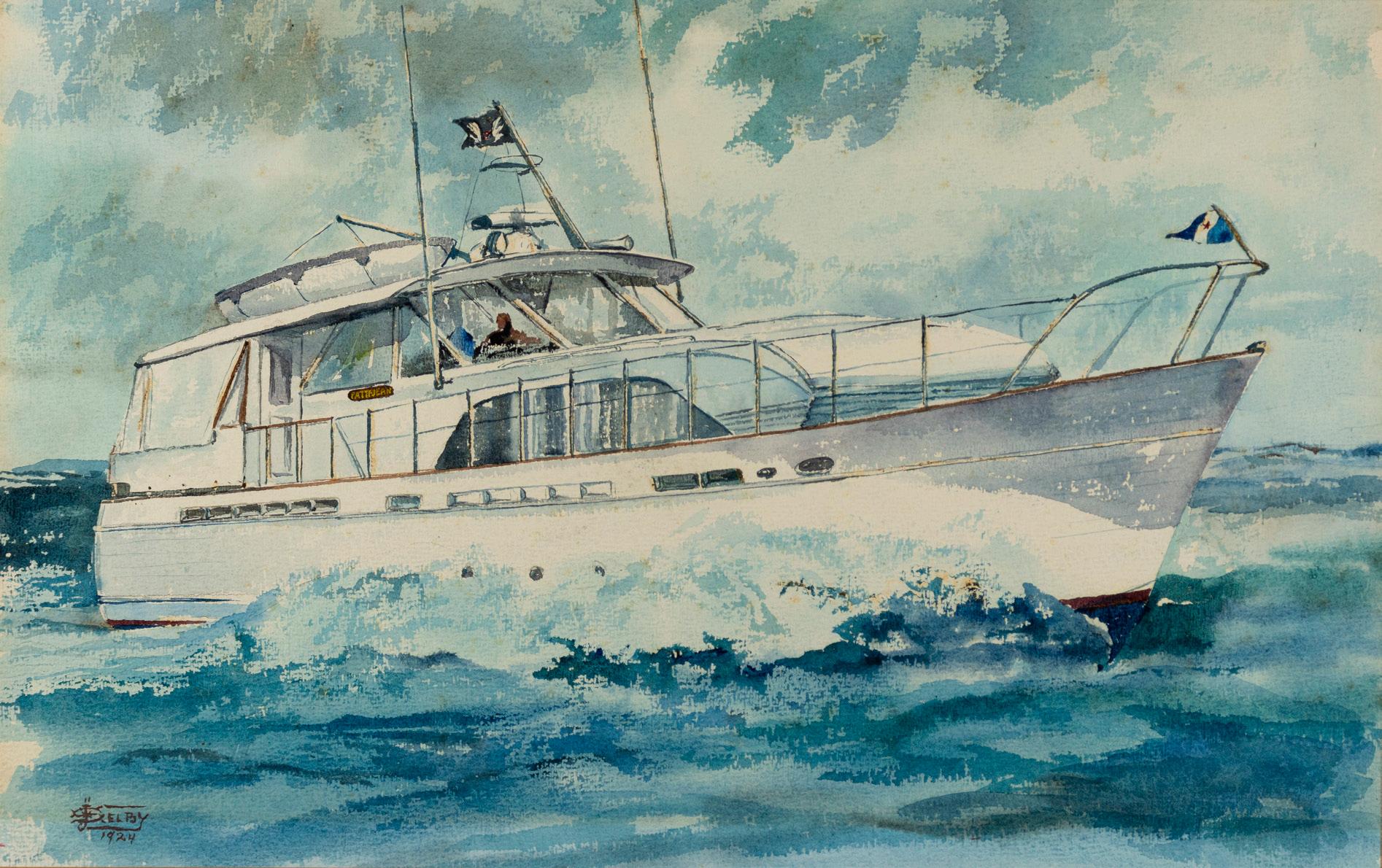
Brooklyn native Vincent Smith documented some of the most compelling events in 20th century America, from the jazz clubs of the New York avant garde music scene, to the burgeoning civil rights movement, and the Black Arts Movement. After a tumultuous youth, Smith found new direction in art, a vocation he completely immersed himself in, both as a student and as a working artist. He took classes at the Brooklyn Museum of Art School and the Art Students League, NY. He traveled to Maine to study on scholar ship at the Skowhegan School of Painting and Sculpture. Smith drew inspiration from African-American artist Jacob Lawrence and was mentored by Lawrence and Romare Bearden.
His first solo show was held at the Brooklyn Museum Art School Gallery in 1955. He participated in numerous prestigious exhibits throughout his career, including at Roko Gallery (NYC), 1955; Market Place Gallery, Harlem, 1956-58; CORE (NYC), 1966; National Academy of Design, 1967; Studio Museum in Harlem, 1969 (one-man); Fisk University, 1970; Pratt Graphics Center, 1972-73; Brooklyn College, 1969; Boston Museum of Fine Arts, 1970; Illinois State
University, 1971; Whitney Museum, 1971. Smith curated the show, Unbroken Circle: Exhibition of African-American Artists of the 1930’s and 1940’s, held at Kenkeleba House, NY in 1986 - of which a majority of the artists make up Melvin Holmes’s collection.
His work can be found in many private and public collections such as The Art Institute of Chicago, MoMA New York, The National Museum of American Art in Washington D.C., The Museum of Fine Arts in Boston, the Detroit Institute of Arts, and Yale University, New Haven.
219
colored etching 14-3/4 x 22 inches, full margins signed and titled, with AP
$800
220 The Black Theater, 1972 etching


6 x 8-3/4 inches (image, full margins) signed, dated, titled, with artist’s proof
$450
THELMA JOHNSON STREAT (1912-1959)
45 Baby on Bird, c. 1943 oil on board 20 x 28 inches signed $10,000
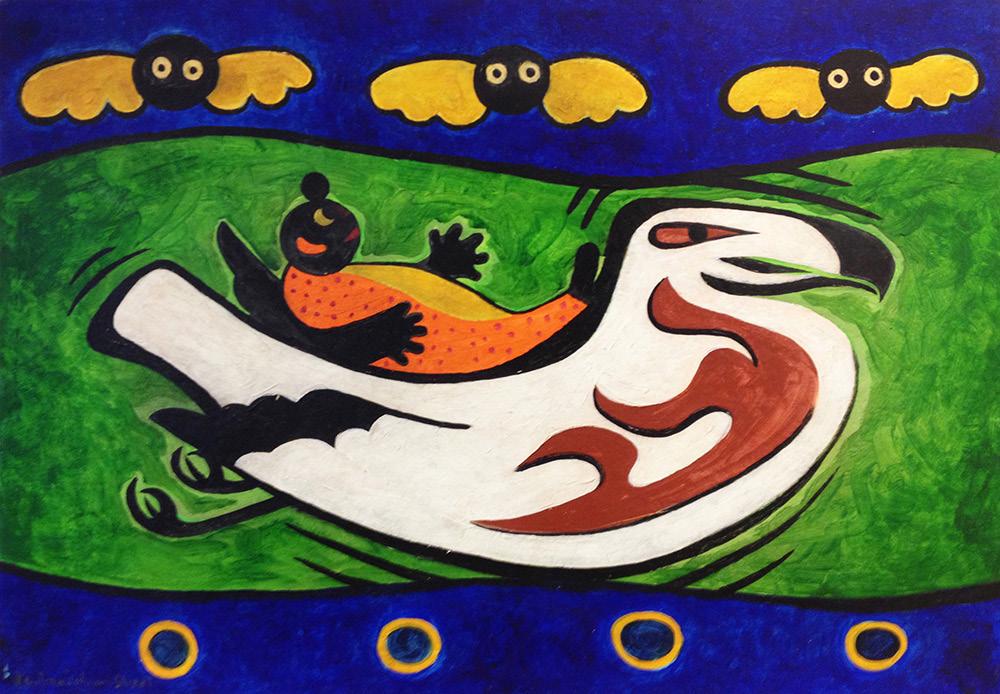
Abstract sculptor, painter, and printmaker, Mildred Thompson was born in Jacksonville Florida. She attended Howard University where she studied under James Porter - the mentorship of whom had a profound effect on her and her work.
Thompson went on to attend the Skowhegan School of Painting and Sculpture in Maine and earned a Max Beckmann Scholarship for study at the Brooklyn Museum School. In 1962, she was also selected for the prestigious MacDowell Colony residency in New Hampshire.
Thompson experienced early success and acclaim for her work in the United States, but due to racial and gender inequalities, decided to relocate to Germany where she taught and exhibited widely throughout Europe. She returned in 1974 when she began a series of artist residencies for the City of Tampa, Howard University, and Spelman College. In addition to her work as an artist and educator, Thompson also served as an associate editor of the publication Art Papers.
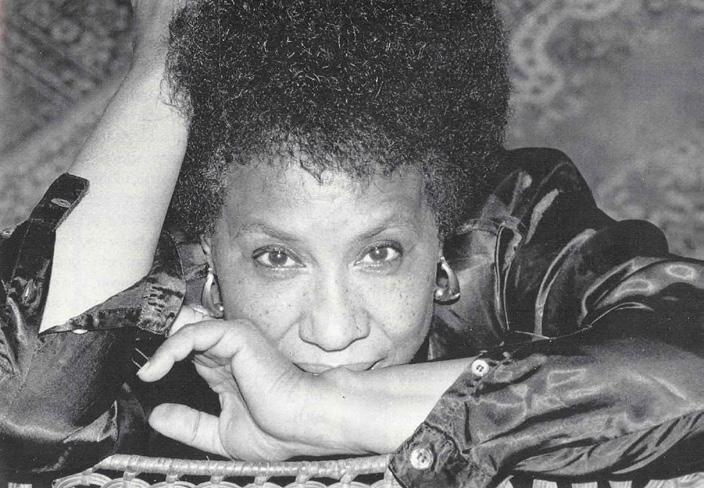
Recently, her work was featured in the 2017
exhibition, Magnetic Fields: Expanding American Abstraction, 1960s to Today which originated at the Kemper Museum of Contemporary Art, Kansas City, MO and traveled to the National Museum of Women in the Arts, Washington, DC, and Museum of Fine Arts, St. Petersburg, Florida. In 2019, Spelman College Museum of Fine Art held Mildred Thompson: The Atlanta Years, 1986-2003
122 Heliocentric Series, 1995 Italio vitreograph 29-3/4 x 23-3/4 inches (image) 38-1/2 x 29-1/2 inches (sheet) signed, titled and numbered 6/20 $4,000
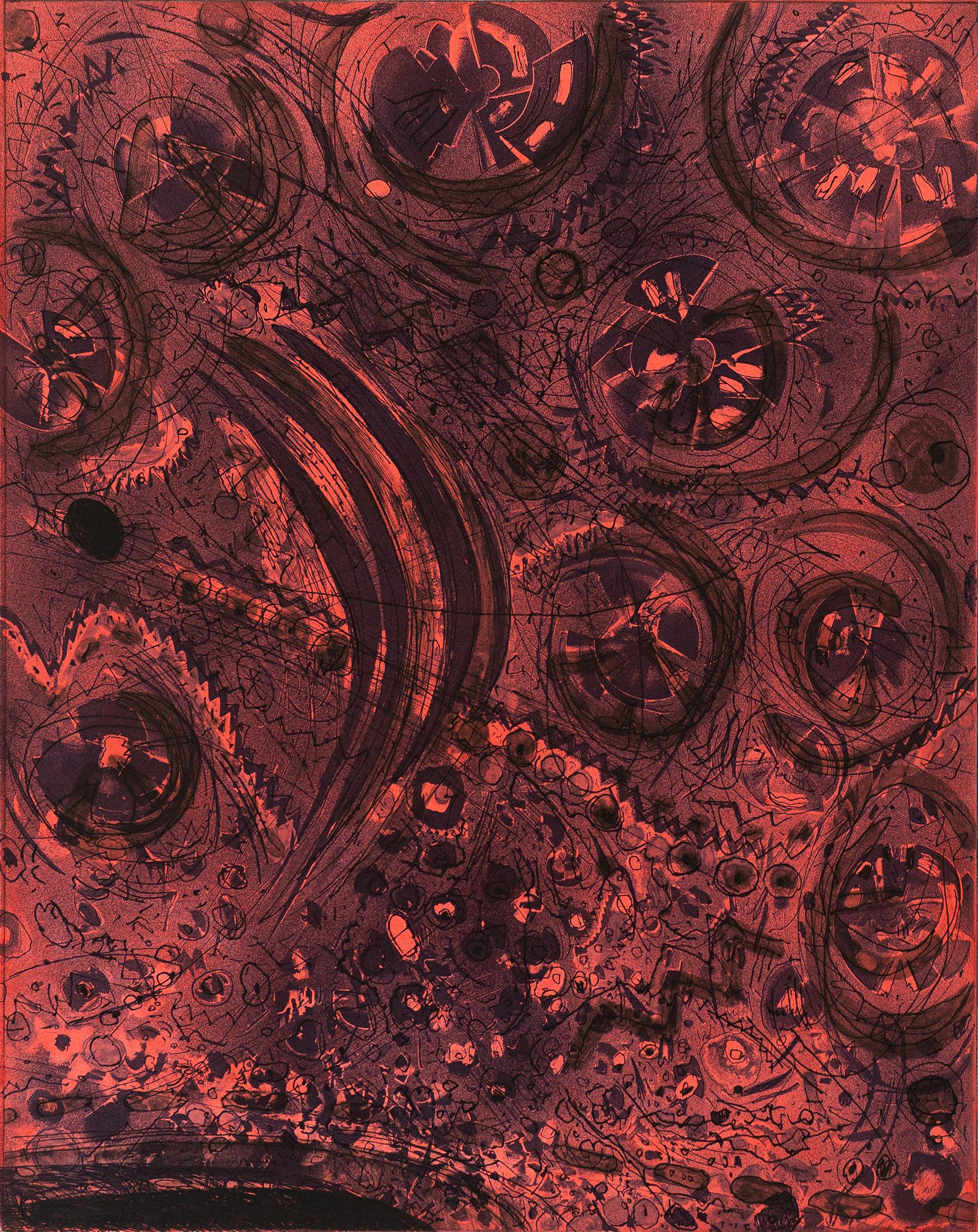

Wells was greatly influenced by African sculptural forms and the work of the German Expressionists, in particular Albrect Durer, Karl Schmidt-Rottluff, Otto Mueller, and Emile Nolde; Cubists, and the Fauves. He worked in a variety of media at this time, although printmaking was a favorite. He created block prints for the publications Survey Graphic, Opportunity, and Plays and Pageants of Negro Life. His work was included in an exhibition of International Modernists in April 1929 at the New Art Circle Gallery owned by J.B. Neumann. Wells was the recipient of a Harmon Foundation Gold Medal in 1931 for his painting, Flight Into Egypt, and in 1933 won a first prize at the Harmon Foundation for a woodcut titled Escape of the Spies from Canaan
He received a position at Howard University in the crafts department - teaching clay modeling, ceramics, sculpture, metal , and block printing. Wells spent two years making a case to move his position and linoleum printing to the College of Fine Arts. The print as an art form, did not yet garner much respect. It was considered a lesser art form to painting and sculpting, but Wells appreciated it for its accessibility.
During the Depression, Wells served as the director of what was to become the Harlem Community Art Center, teaching classes for children and adults. Palmer Hayden and Georgette Seabrooke were his
assistants. At this time, he dedicated himself entirely to printmaking. Wells continued to hone his technical ability by working with Frank Nankivell and spent a year working in Stanley Hayter’s Atelier 17, then the most innovative center of etching and printmaking in the nation.
Wells continued to paint and create prints throughout the rest of his career. In 1961, the Smithsonian Institution held a solo exhibition of his prints, and another solo exhibition was held at Fisk University in 1973. The Washington Project for the Arts presented an exhibition of his oils and prints in 1986. The show was also presented at the Studio Museum in Harlem.
Photo: New York Public Library, Schomburg Center for Research in Black Culture
27 Landscape With House, 1945 linocut on cream thin Japan paper 10-1/4 x 9 inches (full margins) pencil signed, titled and, “4 imp”
Label verso: Print Club of Philadelphia, 1932; Sixth Annual Exhibition of American Block Prints, April 19-May 21, 1932 $3,125
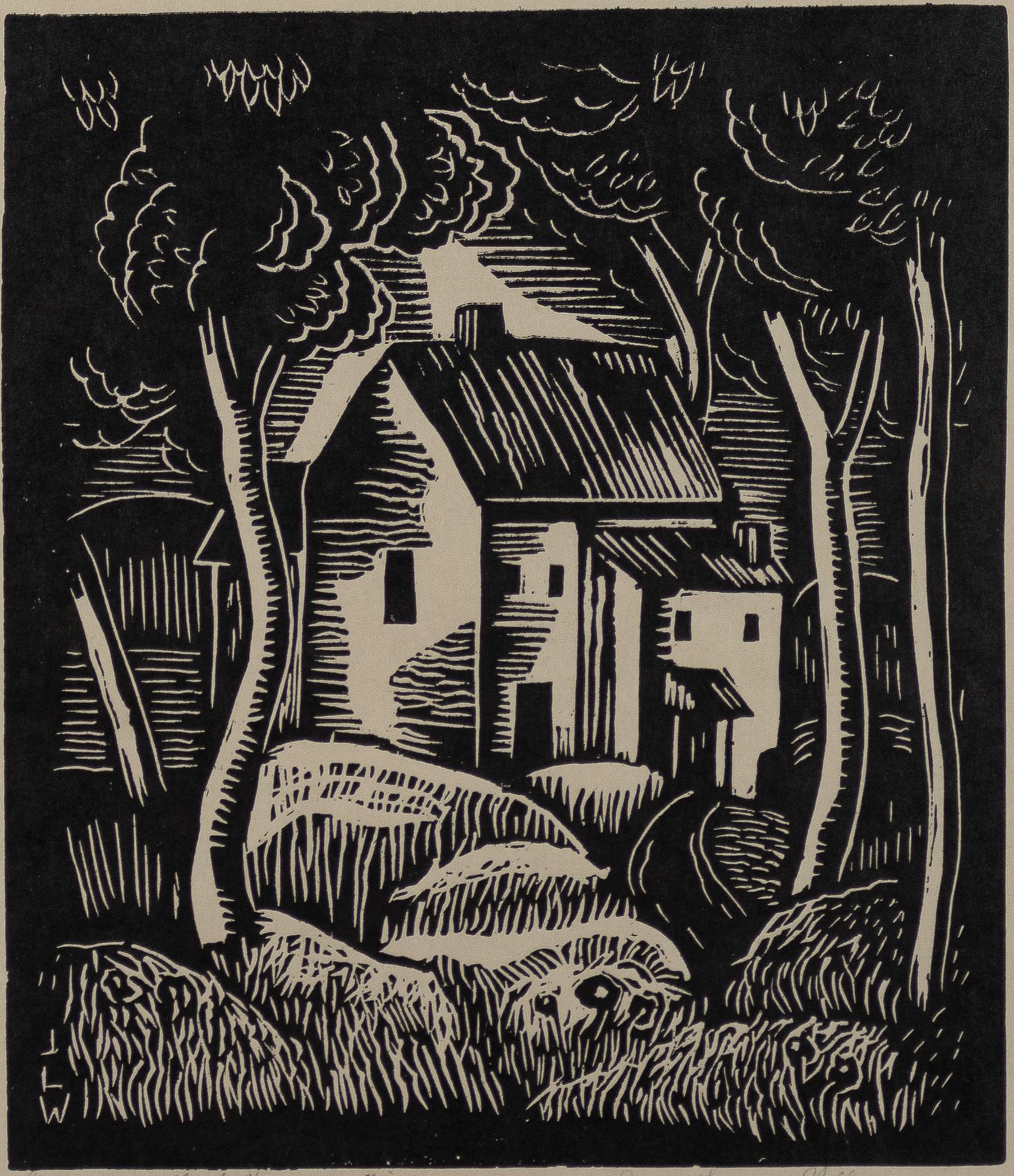
245 African Fetish c. 1929-30 woodblock print on paper

7-1/2 x 6-1/4 inches signed, titled, with “10 imp.”
$1,700
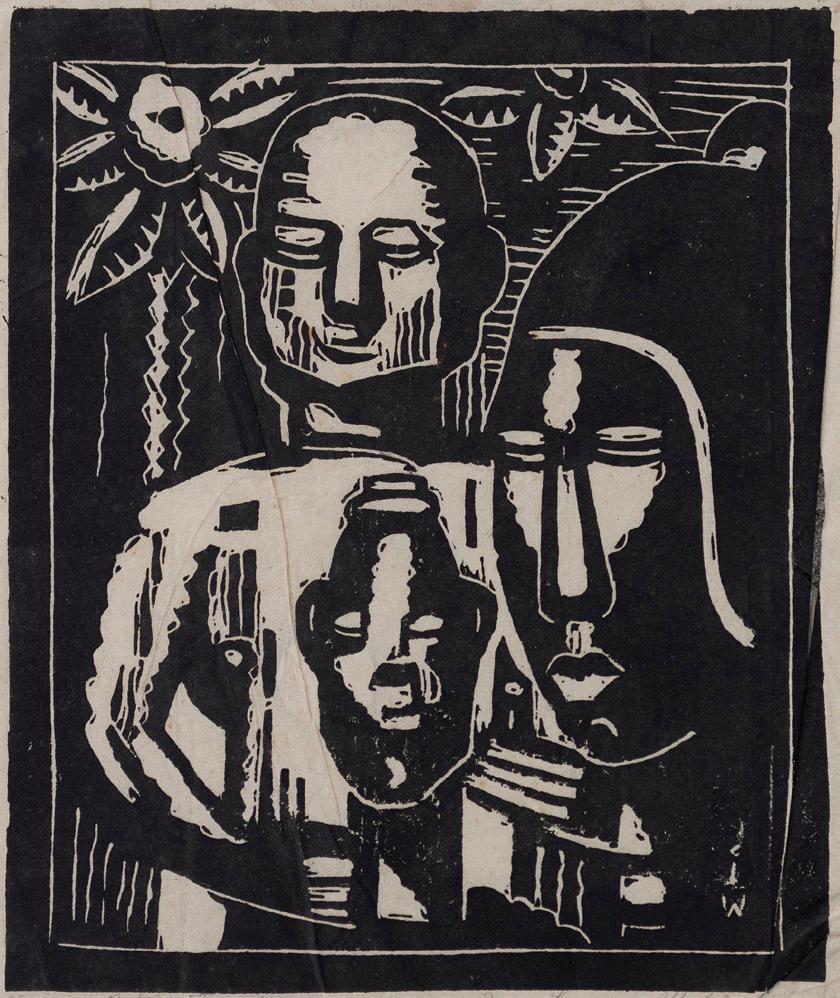
41 Primitive Boy, 1928 linocut on Japan paper
8-7/16 x 5-5/8 inches (image) 13-1/4 x 12-1/8 inches (sheet) signed, titled, dated and numbered, 7/35
$3,125
244 Still Life c. 1945 colored linoleum cut print 11-1/2 x 18 inches (image) signed, titled and inscribed, “proof” $1,700

Born in 1918 in Chicago, Charles White was initially an introverted child, preferring to retreat into a world of reading and drawing. As he grew older, he became more outspoken, influenced by Alain Locke’s The New Negro. As a student at Englewood High School, alongside other future notables such as Margaret Burroughs, Eldzier Cortor, and Charles Sebree, he often clashed with his teachers over their whitewashing of historical subjects. He joined George Neal’s Art Crafts Guild and gathered at the studio of Morris Topchevsky, where he was able to further explore his views of art, politics, and the role of the African American in society.

White graduated high school in 1937 and went on to study at the School of the Art Institute of Chicago. He was subsequently hired by the Illinois Art Project in the easel division, but transferred to the mural division, where he worked with Edward Millman and Mitchell Siporin. His first major mural, Five Great American Negroes, was completed in 1940. His work was also exhibited at the American Negro Exposition, winning several awards.
White married Elizabeth Catlett in 1941 after meeting her at the South Side Community Art Center, and the pair moved to New Orleans where they both taught at Dillard
University. Two consecutive Rosenwald scholarships allowed him to study lithography at the Art Student’s League of New York with Harry Sternberg, as well as travel the Southern United States. He used this opportunity to observe and paint black farmers and laborers for his mural, The Contribution of the Negro to the Democracy of America.
Catlett and White relocated to Mexico where they both became involved with the Taller Grafica de Popular. After their divorce, White returned to New York City. His work retained a figurative style which stood in stark contrast to the burgeoning abstract movement occurring at the time. He used drawings, linocuts, and woodcuts to celebrate the historical figures who resisted slavery, as well as ordinary African Americans struggling amid great social injustice in a post-slavery America. Despite their small size, these works conveyed the power of a mural.
In New York in the 1940s and early 1950s, White showed his work at the progressive ACA Gallery and was a prominent member of African American and leftist artist communities. White moved to Southern California in 1956, and his career flourished as he embraced drawing and printmaking more fully, pushing at the boundaries of his media while continuing to engage with civil rights and equality. Despite his rejection of the prevailing style of Abstract Expressionism and ongoing use of an expressive figuration, he found critical acclaim in the United States and abroad.
White was the second African American to be inducted into the National Academy of Art and Design in 1975. Charles White: A Retrospective was held at the Art Institute of Chicago in 2018. This exhibition traveled to the Museum of Modern Art and the Los Angeles County Museum of Art, 2019.
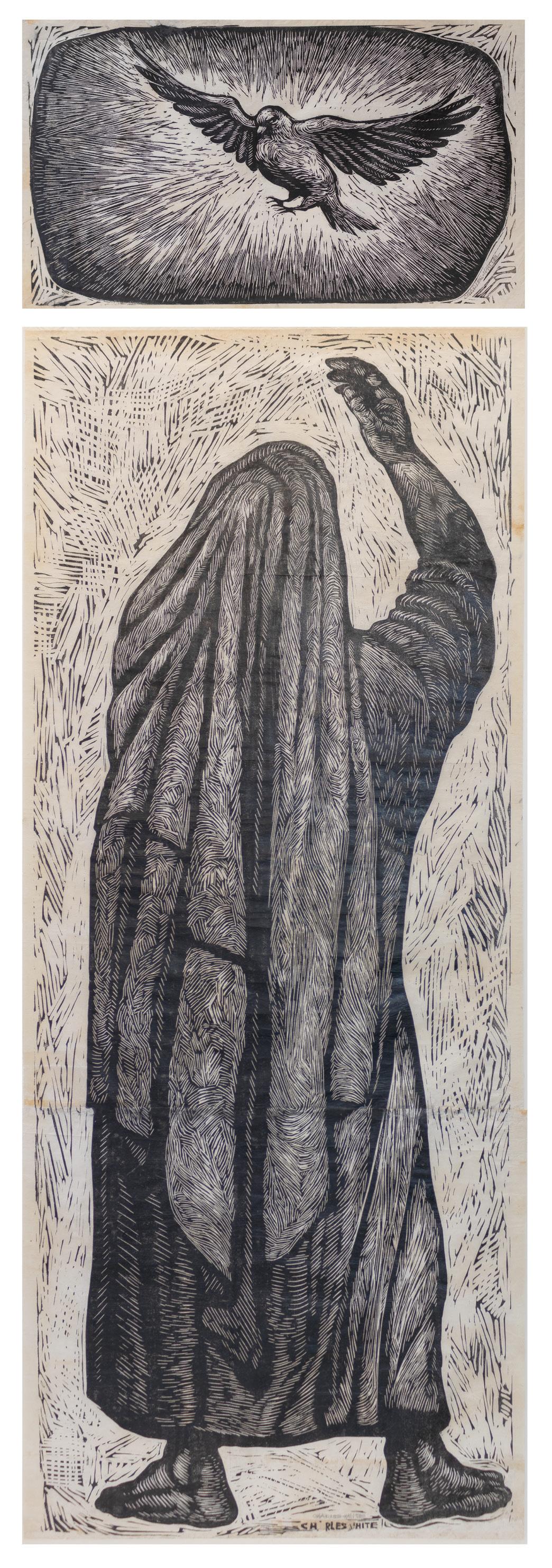
23 Peace on Earth, 1953 linocut on paper in 2 parts 13-3/4 x 23-1/2 inches, signed (upper section)
57 x 23 inches, signed and numbered 1/2 (lower section)
Peace on Earth is fully cataloged in Lucinda H. Gedeon’s research material on Charles W. White, box 2, folder 5 (pp.382 and 374), Eb10, Archives of American Art, Smithsonian Institution
Provenance: private collection, Dallas, TX
$65,000
61 Young Woman (Head), 1967 drypoint 11 x 7-1/2 inches (image), full margins signed, dated, and numbered 87/125 $3,500
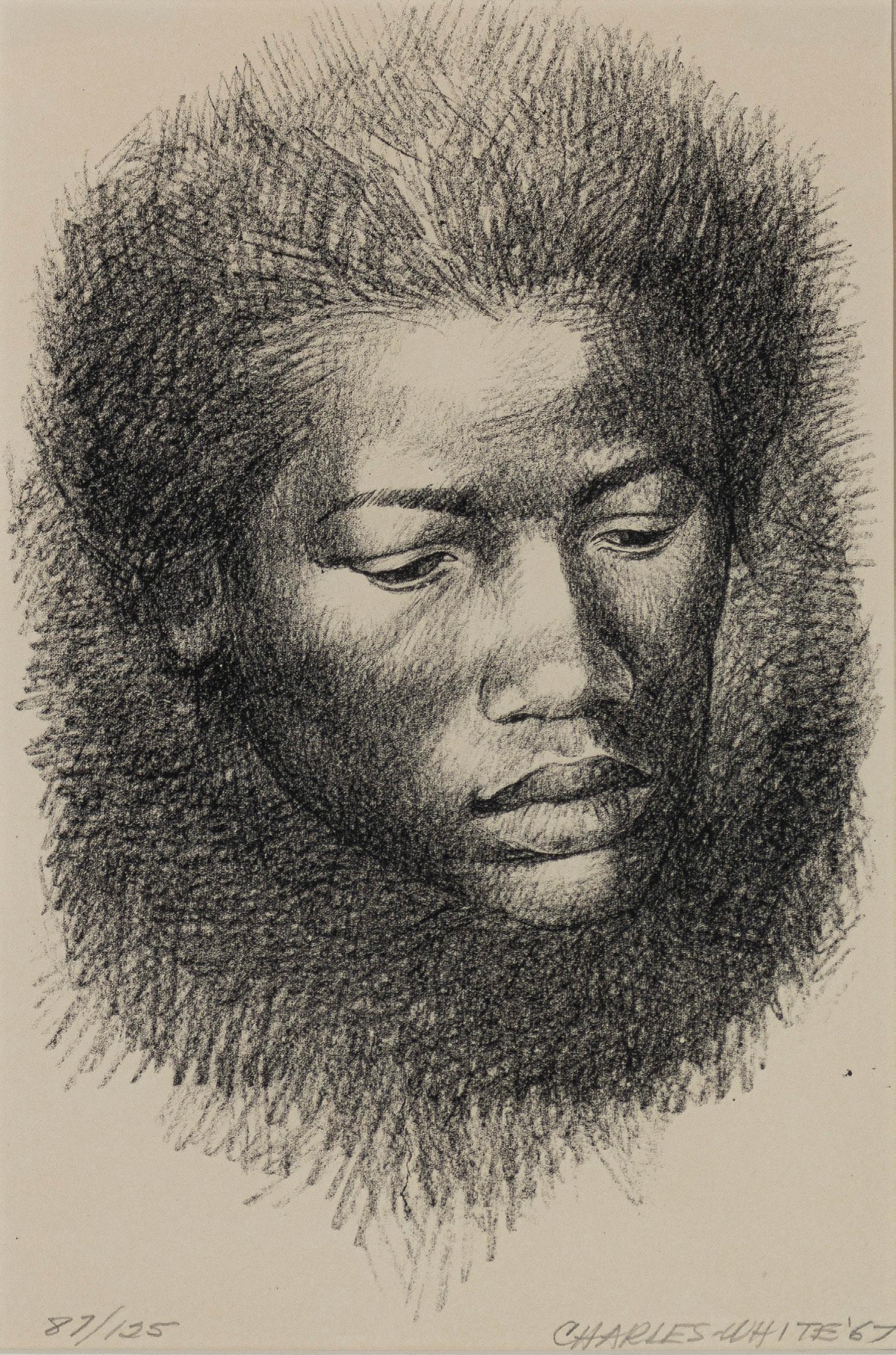
Ellis Wilson was born in Mayfield, Kentucky in 1899. After finishing high school, he left his hometown for Chicago to study commercial art at the School of the Art Institute of Chicago. He joined the Chicago Art League in 1925 - members which included, Richmond Barthé, Charles Dawson and William McKnight Farrow. Wilson’s earliest works were largely academic in nature - still lifes and landscapes that revealed little about the artist.
Shy and quiet, Wilson refrained from taking any political stance throughout his career as an artist, however, he did become motivated by Alain Locke’s speech at The Negro in Art exhibition in Chicago in 1927 to begin creating works that were representative of African American life. Wilson moved to Harlem and then settled in Greenwich Village. He continued to work full time while painting and studied portraiture with Xavier J. Barile on the weekends. His work was featured, most notably, at the Harmon Foundation’s 1930 and 1933 exhibitions as well as Augusta Savage’s Salon of Contemporary Art (1934) and the American Negro Exposition (1940). He was also a member of the Harlem Artists Guild. In 1935, he was employed by the Federal Arts Project mapping division, creating highly detailed geographical dioramas of New York City.
Wilson began applying for a Guggenheim Fellowship in 1939, so he could fully commit to painting. His personal style was evolving,
taking inspiration from contemporaries Jacob Lawrence, Horace Pippin, and Aaron Douglas. When he received his fellowships in 1944 and 1945, he traveled through the American South - Graves County, Kentucky; Georgia; South Carolina; and the sea islands, painting social realist scenes of African Americans and their daily life. Art historian and critic Justus Bier was able to secure Wilson a one man show at the Speed Museum in Louisville, Kentucky based on the merits of these works.
His second one man show in 1951 at the Contemporary Arts Gallery featured works from his first visit to Haiti, where he made subsequent trips to paint. A retrospective of his work was held in 1971 at Fisk University in conjunction with William Artis. His work is found in the collections of Howard University, Studio Museum on Harlem, National Museum of American Art, and the Amsted Research Center.
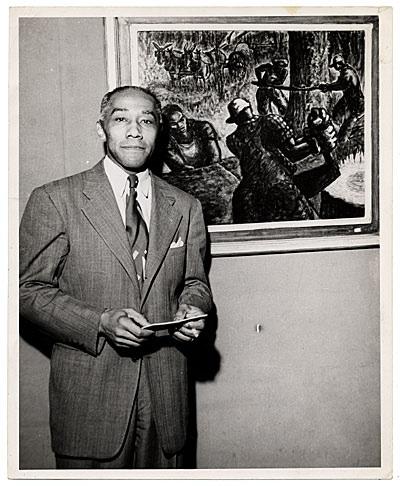
26 Portrait of Margot Fonteyn, c. 1945-50 oil on canvas 20 x 16 inches signed

Margot Fonteyn was an English ballerina, dancing for the Royal Ballet, and was appointed prima ballerina assoluta of the company by Queen Elizabeth II. Immediately following WWII, she became an international celebrity with considerable exposure in the United States. Interestingly, early in her life she lived briefly in Louisville, KY. Wilson was born in Mayfield, KY and had several successful exhibitions in Louisville in the late 1940s, when Fonteyn’s celebrity was at a peak in the U.S. He may have been aware of her public identity and/ or her history in Louisville, and chose to paint her portrait
$7,000
(active 1970-2000’s) 120 Untitled, c. 1975 acrylic on canvas 58-1/4 x 93-3/4 inches signed $7,000
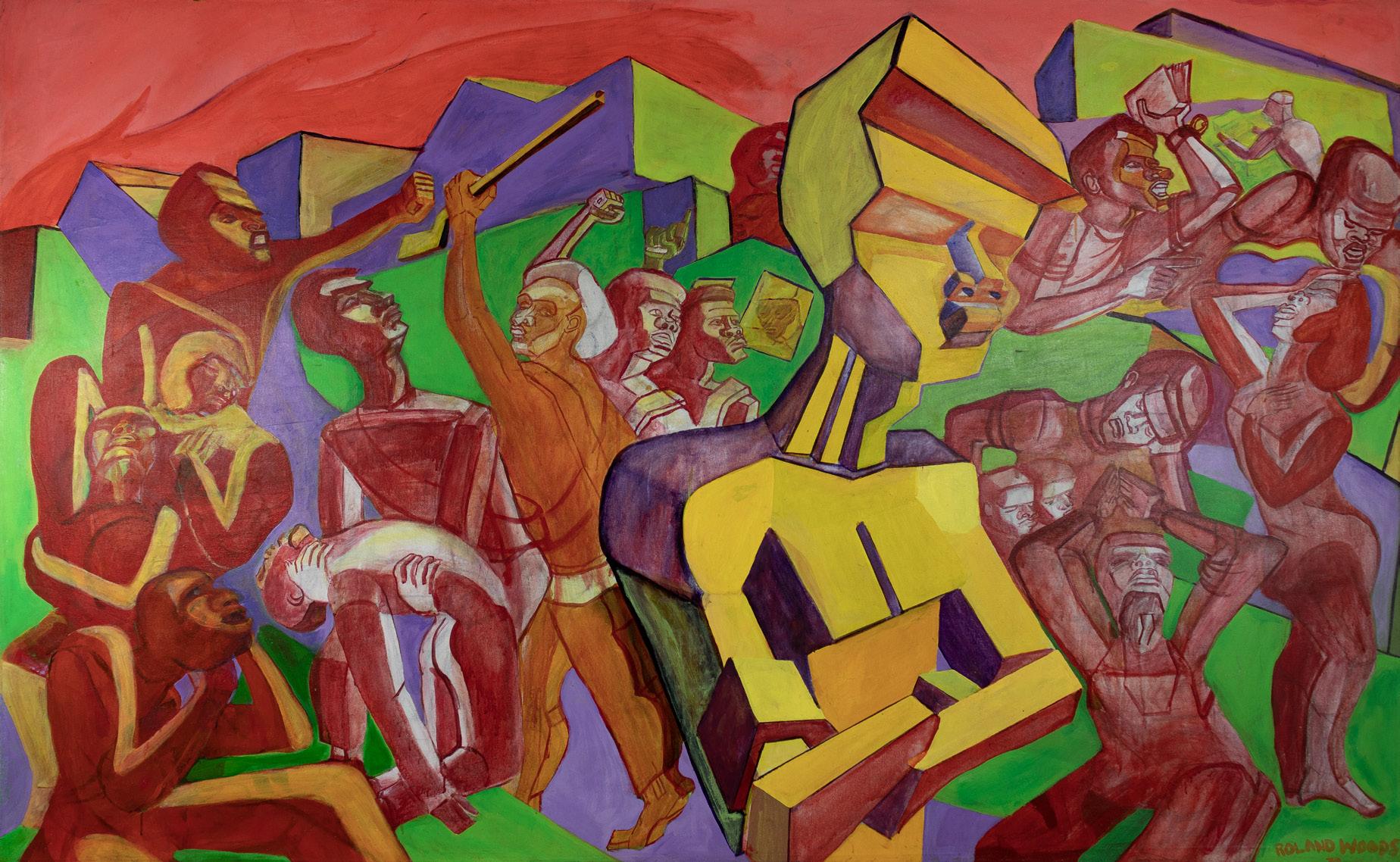
Purvis Young was an entirely selfeducated outsider artist from the Overtown neighborhood of Miami whose work was characterized by a blending of collage and paint applied to found surfaces. He was born into poverty in 1943. He never finished high school, but read whatever he could get his hands on at the library every possible moment. After a stint in prison in the 1960’s, he became inspired by Vietnam War demonstrations and protest art, especially the Wall of Respect mural in Chicago, painted by members of the Black Arts Movement. He created his own mural along a deserted stretch of Goodbread Alley in Overtown, tacking up his own paintings. After two years, his work began to draw attention from tourists, the media, and eventually, the owner of the Miami Art Museum, who briefly became Young’s patron.
Young’s magic realist paintings featured primitive calligraphic lines, often crowds of angels watching over turbulent cityscapes. His personal iconography included horses, which represented freedom, angels and large floating heads which represented hope and the goodness inherent in people, and round blue shapes which represented an all seeing establishment.
His intriguing personal journey was the subject of the documentary, Purvis of Overtown, in 2006. The exhibition, 30 Americans, at the Corcoran Gallery of Art, Washington D.C. featured his work in 2012. Young’s work may be found in the collections of the New Orleans Museum of Art, the High Museum of Art, the Smithsonian American Art Museum, and the Philadelphia Museum of Art.


